#the amount of talent and love that went into this movie despite its whole premise reading like a bad joke is WILD okay
Explore tagged Tumblr posts
Text
life ain't so complicated | see no evil, hear no evil (1989)
#sorry about the watermark but i am not paying 192 us dollars to get rid of it#the amount of talent and love that went into this movie despite its whole premise reading like a bad joke is WILD okay#both genie and richard put a lot of effort into researching and spending time with disabled people to make sure they were telling a story#that is true to the feelings and experiences of the Blind and Deaf without coming across as stereotyping and offensive#and the end result is something that is so gentle and warm and funny that it's. literally insane it makes me bonkers#it's not wasted on this film perse... but also this movie is so gd bad <3 bless <3<3#raf rambles :)#vid#see no evil hear no evil#gene wilder#richard pryor
6 notes
·
View notes
Text
The metanarrative’s grand narrative: Osomatsu-san’s characterization throughout the franchise
The growing cynicism throughout the entire Osomatsu-san franchise shows itself in season 3 with more prominence than anything prior. I think that’s pretty common amongst any “long-running” gag comedy - replacing a plot with spiteful commentary that’s admittedly pretty hit or miss at times. However, it invariably creates a negative but pretty funny character growth, and I love the way the show (I’m including the movie too as “canon” material considering season 3 has referenced it way too many times for me to disregard) has set up this metanarrative across seasons. Long post ahead.
Obviously, Osomatsu-san is self-aware and has a casual relationship with itself. No linear plot (though S3 seems to be trying it out and I’ve enjoyed it - I love that they’re willing to experiment), rather a collection of unrelated skits; and so it points out its own metanarrative because of this “lack of consequences.” With comedy comes impermancy and Ososan AND -kun will always bounce back from that week’s insanity. From the Oxford Dictionary, a metanarrative is “a narrative account that experiments with or explores the idea of storytelling, often by drawing attention to its own artificiality.” Basically: a story about stories.
On top of this, is what I’m calling the “grand narrative,” which is often used interchangeably with metanarrative, but here I’m making a distinction to make it less confusing. Of course, Ososan is a story about stories, but with that comes a story it’s not directly telling, which is where most of the (little) character development is taking place. This is what I’m going to call the grand narrative of a show whose premise is being a meta-aware comedy. I’ll admit I’m by no means an expert on these subjects, but storytelling methods are something I enjoy trying to analyze. As a media format, Ososan really utilizes the fact that it’s a tv show.
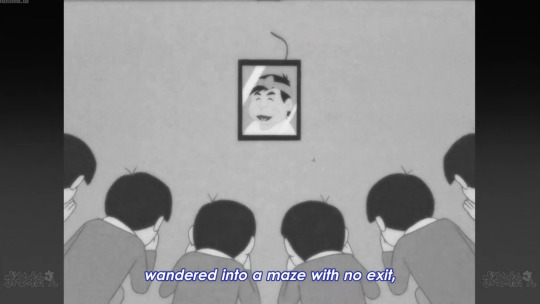
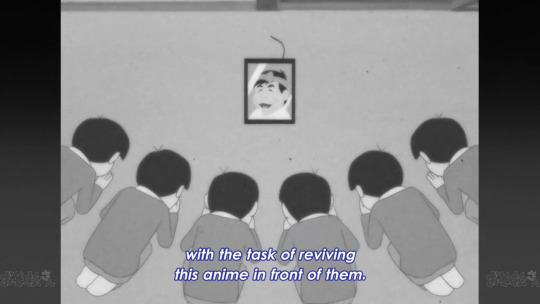
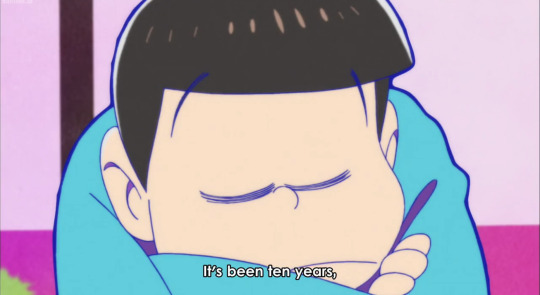
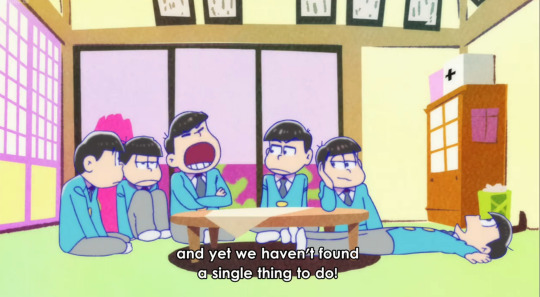
Right off the bat S1E1 makes it clear what to expect: Nothing. Not a damn thing. But, the show had already been cleared for this first season, so it has to be produced. This same episode’s preview is done by Osomatsu, which I’m just gonna quote instead screenshot because there’s too many.
“...we plan on properly starting the anime the next episode.” “...you ended up with an extra minute, so you need me to do something to fill it?! Actually, is this anime going to be okay with episode one being like this? I’m getting worried about how the rest of this is going to be...” “There, I used up a minute! [EPISODE ENDS]”
Episode one is not only batshit referential, but downright mocking the state of anime in 2015. Which, truthfully, I don’t have much to comment on in that regard, as I’m not an avid anime fan. However, it does this under the premise of being indecisive about what kind of anime they wanted the Osokun reboot to be.
They’ll do just about anything to stay popular and relevant considering that is, quite literally, all they have going for them as characters in the series and just being characters in general. They may be pieces of shit, but they’re likeable pieces of shit. The dynamics they’ve built upon to be entertaining is encouraged, and they’re basically just roleplaying different skits and fucking around.
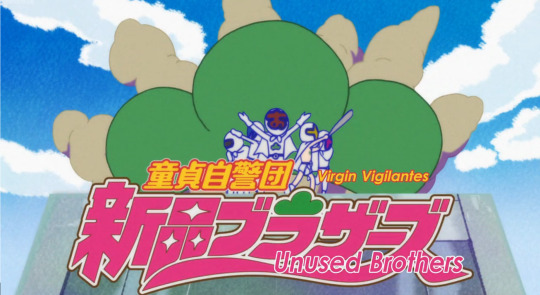

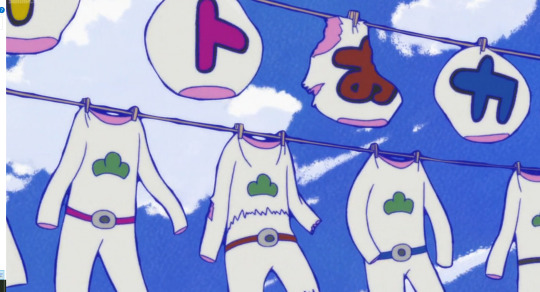
All the AUs! All the skits! They’re just playing! They’re just fuckin’ around!! They couldn’t come up with any interesting plot nor could they “graduate” from being anime protagonists and join the real world, so they just fuck around and make a gag anime!
Even if we follow both as the audience, the show makes a difference between the what’s them in their “normal life” (crazy begets crazy, no?) and what’s their “show.” But, really, that’s just one way to look at it, as they don’t really follow any rules as a show. I could say the Joshimatsus are separate characters from the sextuplets, and it’d be a “correct” interpretation. It doesn’t really matter - I’m choosing to examine it all as being the six of them just running around and playing, because being entertaining and having fun is all they know as characters. Besides, having it blended together beyond recognition reinforces how it prioritizes entertaining us, the audience, above logic. Storytelling doesn’t need to make absolute spatial-temporal sense for it to be enjoyable to fans.
In any case, that mentality really seems to be what pushes their character development negative, as they look to reinforce habits and rituals despite them being really detrimental for them in the long run. They know they’re popular characters as is, and with really everyone from staff to fans encouraging this behavior further, so they see no point in fixing what isn’t really broken.
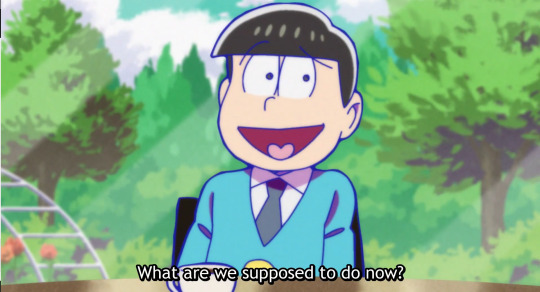

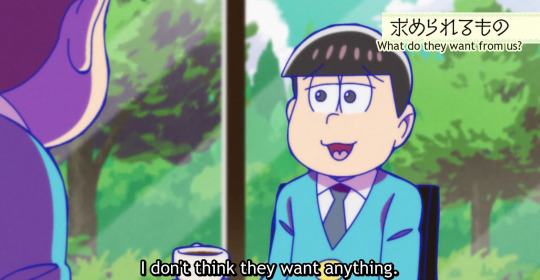
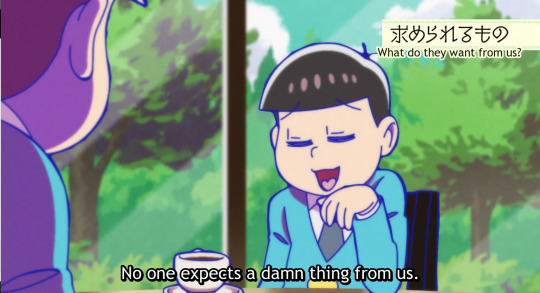
I found this 4 year old article from Manga.Tokyo discussing the Ososan phenomenon in Japan because while the craze died off pretty quickly in American anime circles (which deserves a whole other post), Japanese fans went fuckin’ nuts.
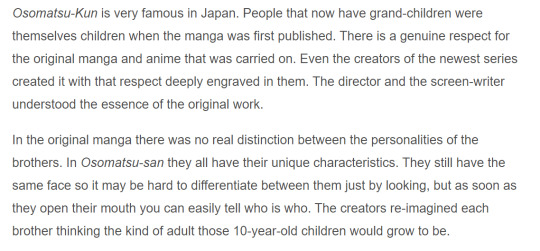
This portion caught my attention, as it makes sense that entitled and enabled asshole children would grow up to be entitled and enabled asshole adults. The article also goes on to compare them to idols (even beyond the F6 spoof) and that they are rooted in being comfort characters above all else.
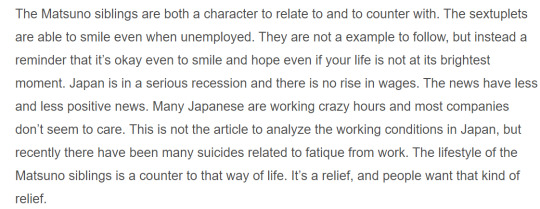
It’s worth a read, especially because Japanese fan response is what drives majority of the content post-S1, and, inevitably, ties into their character development.
They know that they’re Characters, particularly Protagonists. You know what happens to protagonists? Everything works out. Just about every single story created has stuff working out for protagonists. In fact, we have a whole genre made that separates stories with bad tragic endings from our Normal Stories. Ososan is a comedy, not a tragedy, so surely there’s gonna be some payoff somewhere along the road, especially as the seasons and other content are still being pumped out. To a self-aware, entitled, enabled protagonist, assuming everything is just gonna work out for you isn’t that far off from your narrative truth.
However, Ososan is a gag anime, and a lot of gag content (like 4koma mangas) is dropped for other projects before any emotional cathartic ending is provided for characters and fans alike. So, three seasons and a movie later, nothing has happened. It’s a great idol cash cow with a Family Guy filter, and the characters (and writers) don’t even bother to hide it anymore. And I know I’m being hypocritical concerning my definition of “canon material” but I think this portion from one of the drama cds “Choroplex” basically summarizes my point:
CHOROMATSU: Wait, don’t make this into a gag! You don’t even care about becoming employed, right? KARAMATSU: There’s no way that could happen... CHOROMATSU: What kind of future are you imagining? Is it nothing but this? [HUGE PAUSE BEFORE THEY MOVE ONTO SOMETHING ELSE]
They’re parodies of themselves and are running out of ideas. Stagnation and decay is normal, if not unavoidable, at this point in time for them. They’re just 20 somethings who’ve hit a wall but they’re too scared and insecure to bring about permanent positive change. It’s easier for them to fall back into normal patterns and joke off the rest.
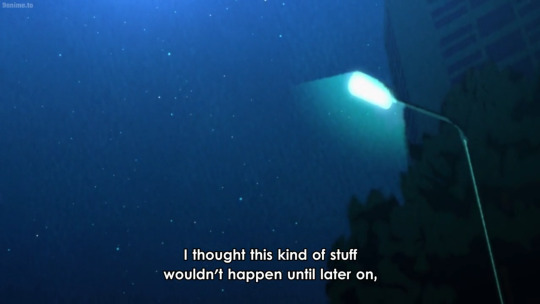
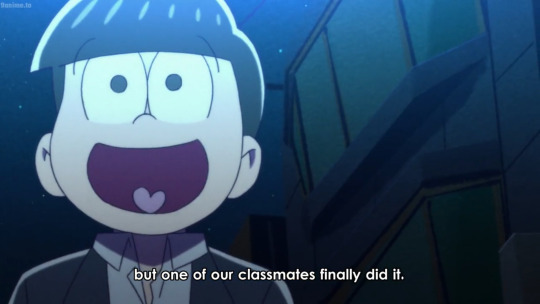
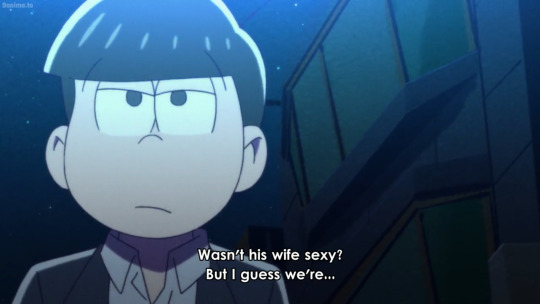
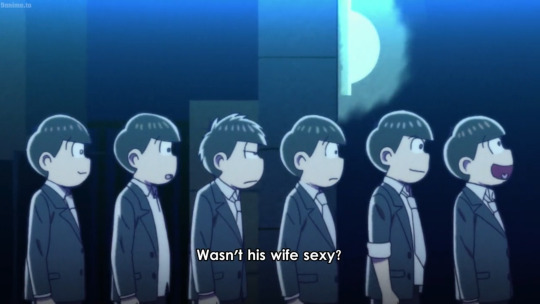
They have an antagonistic relationship with expectations. They can’t handle a single iota of expectations, or responsibilities. They’ve never needed to worry before, so why bother now? Once the biggest hits on the block, now they’re just guppies in the ocean, and there’s nothing they believe themselves to be able to accomplish to keep up with this big brave new world. This is epitomized in S3E15, where old man Osomatsu tells a bastardized version of the Tortoise and the Hare, blatantly projecting his feelings onto it. Again, too many screenshots so let me pull more quotes (bolding for my own reference):
“The place that the tortoise thought was the goal was not actually the goal. His journey down the road of life still continued on. The tortoise was quite tired, but he continued running anyway.” “No one actually knew who was in front anymore. There are too many people above you.” “After the tortoise found out how society worked, he thought, ‘So this is the difference in talent? No amount of hard work is going to fix this. All right. I’m done competing with others.’”
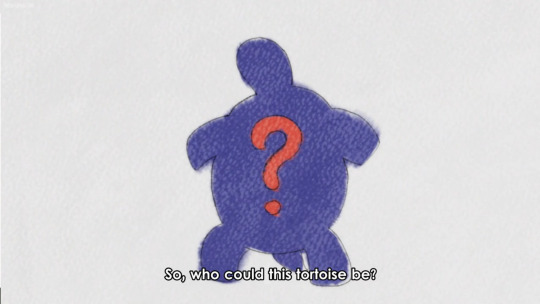
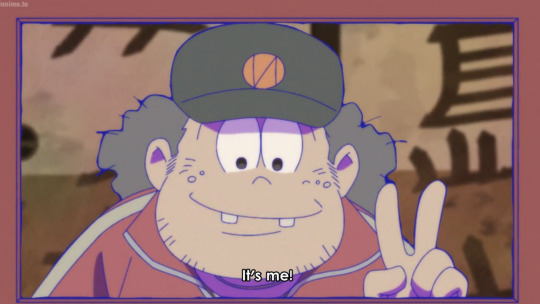
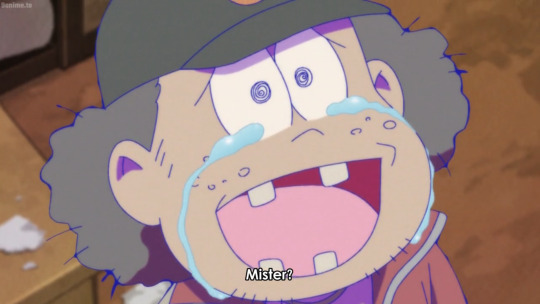
S3 has left more questionable endings than its counterparts. The last 2 skits I referenced don’t even a gag to them, and the marriage skit doesn’t play music for the entire second half of S3E5. There’s more involved too. I haven’t even brought up the rice ball twins becoming actual entertainers in their universe, or how they introduced this whole AI subplot only to reject it because All Six Of Them aren’t interested in expanding their little corner of the world. Here’s a transcript of the ending preview from S3E1:
“Hey, hey, Osomatsu here. I thought we were saved from being replaced, but I guess we get new characters next week. Man, we’re busy. New encounters, changing surroundings... We’re NEETs to begin with because all that is a pain. I guess a lot can happen after three seasons. [EPISODE ENDS]”
The sextuplets’ mindsets are extremely self-centered, which is also an environmental thing (the parents don’t even really care that they’re NEETs, for one) and an understanding of what they ought to be (epic successful protagonists). They also have a very black and white mentality, all or nothing. They’re extremely sheltered, and once they realized where they stood in society at large, they just gave up. To them the world is divided between winners and losers, and somehow, “inexplicably,” they found themselves to have fallen from grace. But they’re protagonists, that has to count for something! Everything’s gonna end up okay, right? Well... what this show has told them: No, not at all. They are consistently compared and warned of Iyami, and are perfectly aware of this fact, and have come to internalize it as a truth rather than a reversible self-fulfilling prophecy.
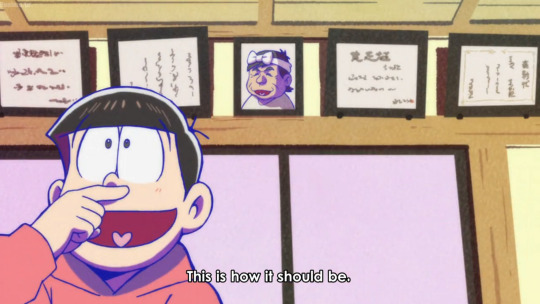
Too many screencaps, taken from the S3S5 marriage discussion:
JYUSHIMATSU: I wonder if we’re gonna get married someday, too. CHOROMATSU: Well, I mean... probably? I’m not exactly sure, but... TODOMATSU: What? You’re gonna get married, Choromatsu-niisan? CHOROMATSU: Huh? Well, yeah... someday.
Surprise! They have commitment issues! The same group that couldn’t commit to a fucking plot! Though their personality issues have several factors involved, I can’t overlook the theater motifs abound. Life’s a stage, and they’re performing entirely unscripted and it shows.
Do I think all of this is 100% intentional on the writers’ part? No, probably not. There’s also an extra layer here regarding contemporary Japanese commentary that I’m not familiar with, so I just ended up focusing on the characters. I can’t be in the writers’ heads, but whatever decisions are being made by executives regarding censorship and “compliance” are reflected in these character changes that result in being significantly more bitter and defeatist.
In the all or nothing, winner-take-all mentality, the only way to save face at this point, in their minds, is to own up to it - act like it’s what they wanted all along. And, hey, it’s funny to watch, right?
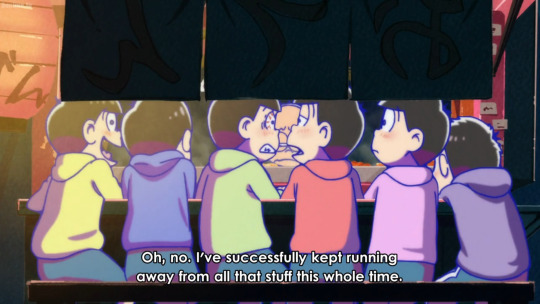
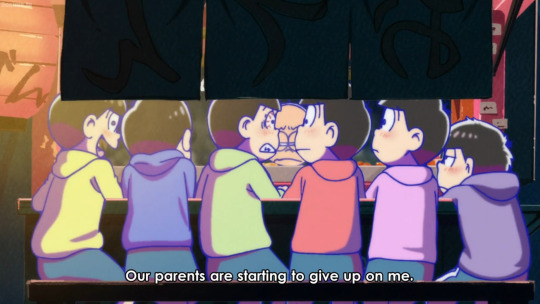
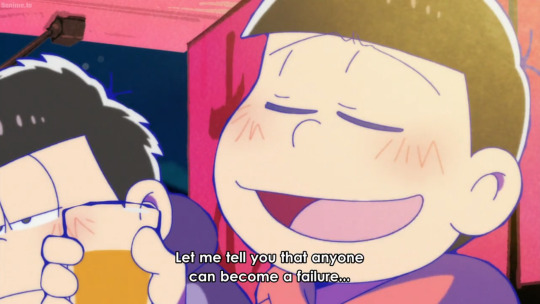
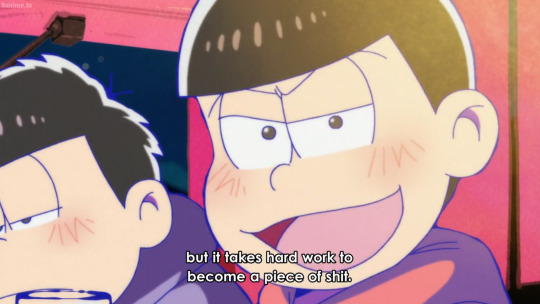
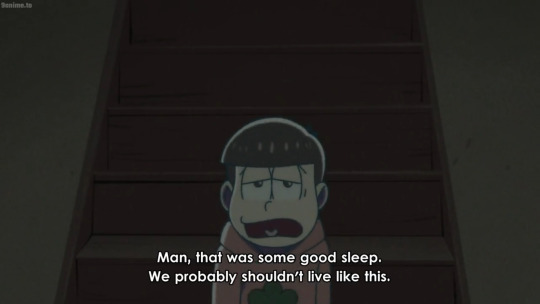
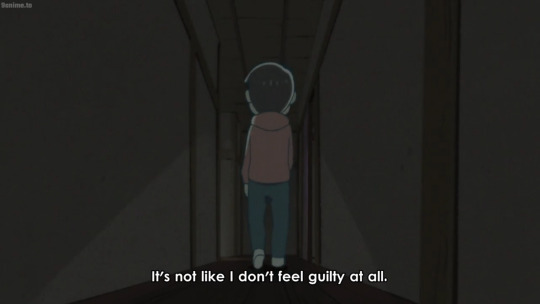
“Why is Osomatsu all my examples”, you might be asking. Well, he’s the damn blueprint for it all. The leader of the bunch, the first personality to grab your attention, has had all his issues projected and ricocheted in their echo chamber.
Ultimately, my point here is that you could think their “canon characterizations” (though canon means nothing in a show like this) as being intertwined with the nature of their self-aware existence. They’ve shown you all their tricks, the smoke and mirrors are getting boring, and they’re stalling long enough the story seems to be moving on without them - in spite of them. And when something genuinely threatens their way of life, they don’t know how to respond.

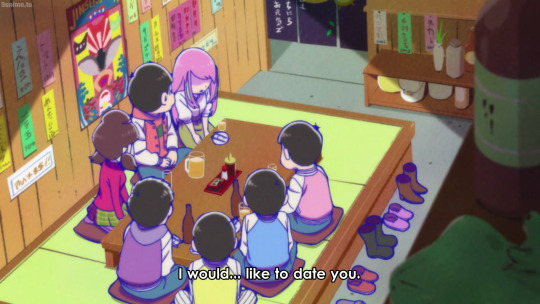

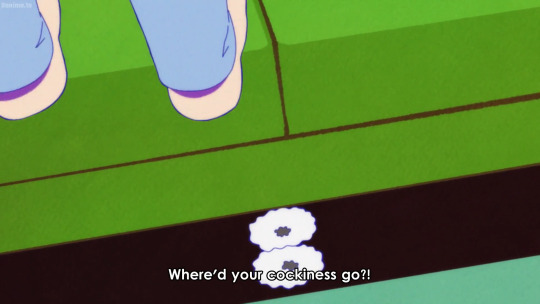
You can play it all straight, of course. Remove the meta jokes and all the same plot points can be hit, but, as a slapstick comedy, it’s able to easily add this additional layer in that I appreciate. I’ve said it in my last post and I’ll probably say it in more, but with comedy comes sincerity - the caveat of all the cartoon violence is that, on some level somewhere, this is how they really feel.
#osomatsu san#osomatsu#karamatsu#choromatsu#ichimatsu#jyushimatsu#todomatsu#osomatsu matsuno#karamatsu matsuno#choromatsu matsuno#ichimatsu matsuno#jyushimatsu matsuno#todomatsu matsuno#analysis#confession this was sparked by a convo i had w friends about s3e18#this is a bit truncated but i couldnt bring myself to make this longer#maybe ill make a pt2 or whatever idk
116 notes
·
View notes
Text
Disney Afternoon History Part 1
Disney Afternoon Part 1
Transcript of: https://itunes.apple.com/us/podcast/the-look-back-machine/id1257301677?mt=2
[music]
0:00:06 Speaker 1: Arthur Herbert Fonzarelli, The Fonz, was the pinnacle of cool for a generation. The leather jacket, the jukebox and "Ayyy". And in 1981, he hit the cultural height of fame with his own Saturday morning cartoon show. Unlike, say, Mork & Mindy in which Robin Williams was limited by the constraints of reality, there's nothing inherently animated about Happy Days, but that wasn't a deterrent for the Academy Award winning studio Hanna-Barbera, when they created this.
[music]
[video playback]
[music]
0:01:19 S1: The animated Fonz didn't just jump the shark, he time traveled so he could ride a brontosaurus. Jumping the shark seemed baked into the premise of many of the cartoons from this period, because they started as a gimmick and only kept gimmicking. Besides a big hit with The Smurfs, this period, for Hanna-Barbera, was littered with Scooby-Doo knockoffs.
[video playback]
0:01:49 S1: The studio that once produced The Flintstones, Quick Draw McGraw, Huckleberry Hound, Yogi, Snagglepuss and The Jetsons was producing uninspired paint by numbers replicas. The parity was at its peak when the animated Fonz had a supporting role in Laverne & Shirley in the Army. The cartoons essentially amounted to barely animated fan fiction. For years, art and commerce clashed on Saturday mornings and commerce had a far better record. And yet, only four years later, a cartoon would raise the artistic bar for the medium, and strangely, it would be based on the currency of kid commerce, candy.
[music]
0:02:34 S1: Animated television started in 1949, as it should, a talking rabbit wearing a suit of armour, riding a horse toward camera. It was the spectacular opening of Crusader Rabbit, whose other animation wasn't nearly as good as the opening. It was designed, with little to no movement, by Alex Anderson, who was inspired by Baby Weems, from Disney's behind the curtain feature, The Reluctant Dragon. In the Baby Weems segment, there are story boards with a tiny bit of motion included to keep it from being entirely static. There are quick cuts, camera movements, and narration to carry the short all the way to the end. After seeing this, Anderson believed he could use this barebones style to have notoriously expensive animation make financial sense for television. He partnered with Jay Ward and the two created The Crusader Rabbit shorts for NBC. The shorts were successful and ran for several years, which sparked Anderson and Ward to create the cartoons that they were famous for, Rocky and Bullwinkle and Dudley Do-Right. Despite their massive success, their partnership didn't end well. In fact, it got worse, even though Ward was already dead. Alex Anderson, animator.
0:03:45 Speaker 2: I was surprised that... To discover that my 50% equity in the characters had disappeared and was not being honored. Yeah, I went to court, sued, got them to acknowledge that I was the creator. I learned about it at his funeral, when I was doing a eulogy and the names of several of us who were doing a eulogy were indicated, and it said Alex Anderson, creator of Bullwinkle and Rocky. And somebody had scratched it out and said, "An artist who worked for Jay Ward." And I thought, "Well, what's this? Why is this in?" Then I started checking and I found that, indeed, Jay had registered the characters in his name.
0:04:31 S1: The show's limited animation technique was taken by Hanna-Barbera and updated with better animation to produce several hits like Ruff and Reddy, Huckleberry Hound, and eventually the Flintstones, a primetime hit for ABC in 1960. Hanna-Barbera went on to an unprecedented run of hits and non-hits, but when it came to television animation, Hanna-Barbera was in a class of their own. However, things fell off in the 1980s. In those years, The Smurfs were their only big hit. This left a gaping hole in the market that was filled by cartoons based on toys, like GI Joe and He-Man. But their ratings were drooping as well. And then something happened that had never happened before. During the entire history of television animation, from 1949 to 1984, the most famous animation company in the world never produced a single animated television cartoon. That was about to change with a single brunch, but the events leading up to that brunch showed an American titan in peril.
0:05:36 S1: Walt Disney was dead, to begin with, he died in 1966. But he was still running the company from his grave. After all the company's internal motto was, "What would Walt do?" But hypothesizing about what a genius would do is not the same as having the genius actually there. Because when it came to the question of "What would Walt do?" the company wasn't guessing correctly. Even though it was 1984, its last motion picture hit had been The Love Bug, in 1968. And so, because the company no longer had Walt, it figured the next best thing was Ron Miller, an ex Ram quarterback and Walt's son-in-law, who became CEO in 1978.
0:06:16 S1: The best quote to describe Miller's tenure was his own, "Because of Walt, because of his influence, I second-guess myself all the time." Miller wasn't only contending with Walt's legacy, he was also dueling with E. Cardon Walker, who was the chairman of the board. Walker had been one of Walt's right-hand men. He was in charge of advertising and public relations. And in his tenure, Walker launched the Disney Channel, opened Epcot and Disneyland Tokyo, but he also had peccadilloes that were killing the company. Walker was not in favor of a $1 parking fee. "The parking lot is the first thing the guests see. We have to keep our prices low." And despite having been in charge of advertising, Walker did not believe in advertising or marketing. The Disney parks did not run ads or commercials. For some perspective, the first American newspaper advertisement was in 1704. In 1922, Queensboro Corp buys airtime from AT&T to create the first radio commercials in advertising history. The first TV ad was aired for Bulova watches in 1941, which cost $9. Advertising was not new, and yet, E. Cardon Walker wouldn't do it.
0:07:26 S1: In fact, Walker was even stingy on advertising when it came to the motion picture division. Budgets for advertising were growing since the big blockbuster Jaws. ET had cost $10 million in ads alone, but when Disney's TRON came out, they gave it such a minuscule advertising budget that no one knew the film was even out. The film took a $17 million write-down. While all this was going on, there was another heir to the Disney throne who was dubbed the idiot nephew by Uncle Walt himself, who once said, "My nephew will never amount to anything." Thanks to Walt-think inside the studio, Roy Disney was considered the village idiot. It didn't help that he wasn't the most charismatic individual. John Sanford, director, Home On The Range.
0:08:11 Speaker 3: He had this legacy kinda handed to him, and I think he really took it seriously. But on the other hand, he was just a normal guy who happened to have a ton of money. We were in La Verne, California, I think it was, at this movie theater. Doing a preview for Home On The Range, and there was a Bed Bath & Beyond, and Patty suddenly turns to Roy and says, "Oh, Roy, they've got glasses on sale. Do you mind if I go looking?" "Eh, go ahead, Patty." And Patty runs into the Bed Bath & Beyond and he says, "You know, we need to get new glasses. You know, you've got kids and they break all the glasses. And suddenly, it's 20 years later, and you don't have one glass that matches. So Patty wants new glasses." And he's just talking very frankly like that. And I said, "Yeah, I know that. I know how that goes." And then Patty comes running up. "Oh, Roy. They've got a wonderful set of glasses that are on sale. Let's go in and get them." And Roy goes, "Well, I don't wanna carry them all over the goddamn mall." And she goes, "Okay. I guess we'll get them later." [chuckle] It was just fun to watch them, 'cause it was like... Reminded me of watching my grandparents bicker.
0:09:12 S1: Roy didn't like his role at the company, nor constantly being at odds with Miller, so Roy left in 1977, but remained on the board. From afar, he watched the animation division go to hell, which was once the company's crown jewel. On Miller's watch, the Fox and the Hound was almost torpedoed, when soon-to-be-legendary animator Don Bluth left the studio after run-ins with Miller and the executives, and Bluth didn't leave alone, he took 15 animators with him. At the time, Ed Hansen, the head of the animation department, said this, "The whole animation department could have gone under at that time. As it was, we made it, but the release of the film has been delayed, and we lost half of our creative staff." Bluth had his own thoughts. "The thing that would help Disney the most is to have a living profit, not a committee. They need somebody who knows and cares about animation. They won't roll up their sleeves and plunge in like Walt did. They wanna hire somebody to do it. It just doesn't work that way. I think they've found that out now. It was a matter of constantly bumping up against Ron Miller and the older guys, people who wouldn't relinquish authority and who wouldn't make a decision except by committee. It just doesn't work that way. They had some of the best talent in the world there. But if a production head doesn't have talent or push, you won't make it."
0:10:29 S1: In spite of everything, the company did have some good news. Miller had gone against the Disney Brain Trust and was making adult fare with his newly-created Touchstone Pictures, and he had a huge hit on his hands with Ron Howard's Splash, on March 9th, 1984. It just also happened to be the same day that Roy Disney decided to resign from the board. Roy Disney's resignation set off a chain reaction. Corporate raiders tried to take over the company. Miller was forced out. Walker retired. Roy took a vice-chairman and chairman of animation role. Michael Eisner became CEO and Chairman of the Board. Frank Wells became President, and Jeffrey Katzenberg took the role of Walt Disney Studios chairman, and the corporate raiders were turned away. Eisner and Katzenberg had blazed a trail at Paramount and became the talk of the town for their track record and by throwing their names into the press as much as humanly possible. Meanwhile, Frank Wells had been vice chairman of Warner Brothers. They set about using their industry experience to transform a company that was run like a mom-and-pop shop.
0:11:33 S1: The fourth member of their team was assets, and there were assets galore that Disney simply wasn't utilizing to their full potential, or at all. The Walt Disney Company was like the drowning man in the flood who doesn't accept help from a rowboat, motorboat, or helicopter because he believes God will save him. The man dies, and he meets God and asks, "Why didn't you come to my rescue?" God says, "I sent you a rowboat, motorboat and a helicopter. What do you want from me?" Now, Eisner, Wells and Katzenberg would take the rowboat, motorboat and helicopter to the promised land. Under their leadership, the company began advertising its parks. Attendance rose 10%. They raised the price of admission, which led to hundreds of millions of dollars into the company's coffers. Eisner releases Disney classics on home video. It was initially sacrilegious in the company, but money talks. Cinderella alone made $180 million in revenue. Animation was losing money, so they thought about shutting it down. But Eisner didn't wanna piss off Roy, so they kept it around. It was a smart choice because Roy was a little bit more cunning than he seemed. He was no Richard III but he'd just usurped his own brother-in-law. And because Eisner would later fail to keep him happy, Roy would take out Eisner decades later. Roy might have been treated like Fredo, but he was secretly Michael Corleone.
0:12:57 S1: But that was a long way off, now Eisner was simply basking in his good fortune. "Such a bounty has fallen in my lap. Every day a new asset falls out of the sky. The real estate is just gravy, there are 40 unused acres next to Disneyland planted in strawberries." To re-emphasize his life on easy street, he was drinking a milkshake when he said that. And of course, there was another blue-ocean opportunity for Eisner to slurp up, animated television. On Eisner's first day at the studio, he announced he wanted to have a Disney TV cartoon on the air in 10 months.
[music]
0:13:35 S1: Willie Ito, animator.
0:13:41 Speaker 4: We knew internally at Disney that things are gonna start happening. And so, one day, they had all of the Burbank employees meet in the backstage set, we had a big open set area and everyone from the studio was there. And Michael Eisner was introduced and the whole bit. Then he gave us the overall picture as to what to expect in the future now that the new regime is here. And one of the things he commented on was we're going to alt Hanna-Barbera, Hanna-Barbera.
0:14:20 S1: According to the New York Times, he asked someone to find them the six most creative people at Disney to figure out how to make Disney TV animation work, which leads to the aforementioned brunch that started it all. One of the creatives brought to the table was Jymn Magon. Magon had produced story records for Disney music for eight years. Why bring a record producer, with no animation experience, to the table?
0:14:41 Speaker 5: I ask myself that every morning when I wake up, [chuckle] it's a bit amazing. Well, one of the things that Michael Eisner did before he was at Paramount was... I think he was head of ABC children's programming, I think he told me that he was the guy who actually bought the Scooby-Doo franchise from Hanna-Barbera, which of course, is still running after all these years. So, that was very successful, and I think he always had a soft spot for TV animation, and so when he took over the company in '84, one of the first things he wanted to do was to start a TV animation department. So, being new to the company, I think he just looked at different departments and said, 'I wanna meet some of the bright people that are doing things here at the company.' And we had just made a lot of money off of Mickey Mouse disco and a lot of projects that were new at the time in the record business. And so Gary Krisel, who was the president of Disneyland records, and myself, were invited over to Michael Eisner's house on a Sunday morning. Michael Eisner invited a bunch of people... Not a lot, I think there were about 12, in all, that were at this meeting in his living room on a Sunday morning in Bel-Air. And I had never been to Bel-Air, never been invited to someone's house up there, [chuckle] so, it was very fancy-shmancy for me.
0:16:01 S1: And there was also Tad Stones, who began his work at Disney in 1974. He was an uncredited animator on the Fox and the Hound as late as 1981. Now, he too was at the brunch.
0:16:13 Speaker 6: I was in Features, I eventually moved into Story, went to Imagineering and help design rides for Epcot Center, and back in charge of some Epcot Center documentaries that then never happened. Eventually ended up back in Features, I'm not sure they knew what to do with me. And that's about the time management changed, with Michael Eisner coming in and Jeffrey Katzenberg and those guys. And I was... Along my trials through the company, I had done some animation development for the guys over in the merchandising side of things 'cause they felt like the only way to really sell toys is to have some cartoons on TV. You can't wait for these features that come out every four years, or so, 'cause that's what it was at the time. Anyway, those same guys were pitching TV animation to Michael Eisner. I was actually on vacation, but I got a call that said, "We know you're on vacation, we know it's gonna be Sunday, but would you mind coming to Michael Eisner's house to talk about television animation?" So I was like "Yeah [chuckle], I think I can make time." Went there with like 10 people. These were the guys who basically I had worked with before and they were impressed with what I had done. And from the beginning, Michael Eisner felt like Disney is the top in animation, and it should be in every area that animation is in, it doesn't mean that television animation is going to look like feature animation, but it should be the best TV shows in animation on TV.
0:17:39 S1: Jymn Magon.
0:17:40 Speaker 7: Michael revealed that he wanted to start this new department, he wanted us to come up with some ideas and whatnot, and he actually came up with an idea himself, which was his kids who were in the other room eating cereal in the kitchen, in their pajamas [chuckle] on Sunday morning, had just come back from camp and I guess they had told him that they were eating these really cool candies called Gummi bears. And he said, "I just like the sound of that." And he looked at me, which was really weird, 'cause he didn't know me at all, and he said, "Make me a show called Gummi Bears." And I thought, "Why'd he pick me out?" [laughter] And I said, "Oh yeah, cool, great."
0:18:20 S6: So I pitched an old project, Mickey and the Space Pirates, they liked it a lot, but then they said, "No Mickey... We wanna make sure we can pull this off. Mickey is too precious." So there was a lot of respect there going in. No one was prepared to actually pitch shows. I had that artwork left over from stuff I had pitched to the merchandising guys, who were in the room, but it was kind of more feeling what Eisner wanted.
0:18:43 S7: But Tad was at that meeting, and he didn't come over for probably a full season to TV animation, but he eventually did, and thank God he did, because we worked on so many shows over there. But yeah, he was at that initial meeting, and he had a lot of great ideas. But he didn't come join us right away. And afterwards, we all met at a coffee shop, in Brentwood, and I remember us all kind of looking at each other, like, "This guy's crazy. Who wants to do a show about characters that get eaten every week?" [chuckle]
0:19:15 S6: And I remember saying, "Well, he seemed pretty sharp and respectful of animation, except for that idea about Gummi bears, that's like doing pepperoni people, or something. I don't know how to do that".
0:19:25 S7: So I think we all kind of felt like, "He's a busy man. This will all go away". It was about two weeks later I got a call, "So where's my show?" "Well, I'm writing it now", [chuckle] and I typed up something and it was horrendous, but it was the beginnings of development. And so I ended up, at one point, doing two jobs, I was still doing my record producing, but I was also developing two shows, both Wuzzles and Gummi Bears for Disney. And we didn't even have offices for the department back then. I remember we went over to a fellow named Lenny Ripps. Lenny Ripps was responsible for creating Full House and he was under contract at Disney for the time, and Lenny said, "Come on over, let's talk about this." And so there was Gary Krisel, who was going to be the president of the new division. So he was doing double duty at the same time, with records and TV animation. And Michael Webster turned out to be our office manager, and there was me. And that was the four of us sitting there around a card table in Lenny's office kicking ideas around. And that's how that department started, very bizarre and very humble.
0:20:47 S7: I remember having to take pitches from people and we were discouraged from doing that, because Disney became a big company and had deep pockets, and of course, people would come in and pitch, and then say, "You stole my ideas." And so pretty much kept to ourselves and almost all the development was from inside, from people on staff. So we didn't... It was in the time of [0:21:10] ____ and other people pitching their ideas from outside. There was a travel office for Disney across the street from the studio in Buena Vista and it was just a crummy old office building. And I think that's where we put Art Vitello when they brought him in to run Gummi Bears. And they were just sort of makeshift offices, they put some of the artists on the back lots, above the tea room. We were just spread all over. So we all became sort of bastard children.
0:21:41 Speaker 8: This is the great book of Gummi.
0:21:45 Speaker 9: What's in it?
0:21:46 S8: Well, we really don't know.
0:21:49 S6: Well, they actually developed Gummi bears kind of on a candy basis with a villain called Licorice Whip, I think. And they were actually gonna have the Gummi bears give dental hygiene messages at the end of every show. That went nowhere, and they threw it all out and came up with what was on the air.
0:22:06 S1: Instead of candy, the show got a complicated 500-year-old plus mythos. The Gummi bears were descendants of the great gummies, tasked with protecting all things Gummi from human greed and exploitation.
0:22:18 S7: I was very fortune that I got to work with two of my childhood heroes, which were Rocky and Bullwinkle. I found myself staring at Bill Scott a lot because besides doing all the voices of George of the Jungle and Tom Slick and Bullwinkle, he was a fantastic writer, and he had written all of these commercials for Quaker Oats, Quisp and Quake and Cap'n Crunch, and stuff like that. He once said to me, "You know the old story, Jymn, about how do you make a statue of an elephant? Well, you start with a block of granite and you chip away everything that doesn't look like an elephant". He says, but writing a script is different. You start with nothing, and you chip away until you have a story. [chuckle] And I thought, "Oh, that's interesting. You don't even have the rock to work with." [laughter] And I just thought he was a delight. He died after the first season of Gummi Bears and that was just devastating for us.
0:23:16 Speaker 10: Welcome to the land of Wuz, where nobody is like anybody you've seen before. The people who live in Wuz are called Wuzzle, naturally. And as you've probably guessed, Wuzzles are a little bit, you know, different.
0:23:33 S7: I didn't stay on Wuzzles. Once we got the two shows sold, I stayed exclusively on Gummi Bears. But in the early days, we were trying to put together these shows to pitch to the networks. And we had a show called Jumble Isle, the idea was that there were these animals that were jumbled up, and there were two of each animal. And, lo and behold, it turns out Hasbro has... Already has a project called The Wuzzles, which they had plush animals at the time. And, again, I don't know the ins and outs of the business side, but it was decided, "Well, why create these things when they already exist and let's just do a deal with Hasbro to take our development and put it with their characters." which I'm not even sure they had much of a back story. But once the deal was made, then we'd develop them into talking, breathing, and living characters. [chuckle] And so what happened was that Wuzzles then went on to have its own production department, just like Gummi Bears had, but like I said, my involvement at that point, I had dropped out after it sold to CBS.
0:24:39 S1: Besides Wuzzles and Gummi Bears, Disney television animation had one more venture in its early years. Fluppy Dogs was the first animated Disney feature for television. The show revolved around the Fluppy Dogs going through an interdimensional portal to Earth. It got a 5.3 rating on November 27th, 1986. The numbers were so low that it killed off the idea for a television series based on the special, and with that, Fluppy Dogs was over before it even really got started.
0:25:08 S7: Fluppy Dogs was sort of the... I kinda call it the albatross around the neck. [chuckle] It was a cross to bear. And I think everybody in the department worked on it at one time or another. And so what happened was that we were gonna do this Fluppy special and it was going to be the kickoff for a series and it just never took off, it never... It just never happened, and I think we were all kind of glad it didn't go any further. I mean, they were cute, but I just remember it being like, "Oh crap, I don't wanna go on another meeting about Fluppy Dogs." [chuckle]
0:25:49 Speaker 11: We've been to so many worlds. I don't know how long it's been since I've seen my family.
0:25:55 Speaker 12: You can talk!
0:25:56 S1: I wish you wouldn't keep saying that, I've been talking since I was 3.
0:26:00 S1: I'm sorry, but I mean, talking dog? Fluppy, and doorways to other worlds? I just wanna find one world, my world.
0:26:12 S1: Disney was going in cheap in terms of the price for pristine Disney Animation. Disney knew they couldn't afford movie quality animation and expect to make a profit. But Disney still spent $285,000 on each episode of Wuzzles. That was double what Hanna-Barbera would spend. It was so much, in fact, that it was $35,000 more than it was being paid by CBS. Why spend so much? The reasoning was simple, if it looked better than everything else on TV, then the characters could become part of the parks, and because of the success rate of their recent films, Disney needed characters more than ever. Willie Ito, animator.
0:26:51 S4: When I was at Hanna-Barbera, Michael Eisner was the VP of Children Programming at ABC. So when we were doing presentations and they would fly out here to review what we were working on, Joe would ask us to come in on a Saturday, sit at our desk as if we're busy bees and then bring Michael Eisner and his people through, and says, "Hey, here, look, they're all working on the new show idea," and then see the presentation. So I knew of Michael Eisner. And so, when he says he's gonna hop Hanna-Barbera Hanna-Barbera, I'm thinking, "Oh my gosh, I came back to Disney to get away from this rat race, and I hope we're not gonna be all caught up in the middle of it." Well, to make a long story short, a few months later, a fellow named Michael Webster, who I worked with in animation, was hired on to be production coordinator for the newly forming Disney TV Animation. Michael got with me and says, "How would you like to come back to animation?" I said, "Michael. No, please don't, don't do this to me. I'm perfectly happy. I'm actually in my new career back at Disney." And he says, "Well, we're gonna have a little boutique operation. All we're gonna do is be responsible for the scripts and we'll do story boards and maybe character design, but otherwise, everything is going to be farmed off to a production house. So we're just gonna have a little boutique operation and let me dangle this carrot in front of their view."
0:28:29 S4: What it was is, he says, "I know you used to make a lot of trips to Japan and Asia, and you know a lot of the production houses over there. So I wanna send you there and meet with these different companies and talk business." And he says, "Well, we'll be sending you first class. You'd stay at the Imperial Hotel in Tokyo." And then all that. How could I resist? Plus, the fact that there was a handsome increase because of my position, would be like an executive thing. "Michael, I'm gonna give you three months. That's what I could promise you." So, "Okay, that's a deal." I did the pilot storyboard for a two-minute pilot. The soundtrack was recorded. They cut the exposure sheets, and the whole bit, and with those two copies under my arm, I flew to Tokyo. As I was registering, this American gentleman approaches me, "So are you Mr Ito?" I say, "Yeah." And he says, "Oh, hey. I understand you're here to make pilot films for your fledging Disney TV animation." I said, "Yeah, I am. You could talk to me initially, but the decision will be Michael Webster, who will be arriving here in about half an hour."
0:29:50 S4: So we sat in the lobby, having a cocktail, and then Michael shows up and he's at the desk and I said, "Well, there's Michael now." So, well, we flag him over and he says... The fellow talking to us says, "What we wanna do is we wanna throw our hat in the ring. I understand you're gonna be talking to people at Toei Animation in Tokyo, then you're gonna be flying to Korea, and you're gonna be meeting with Steve Hahn at the Korean studio." I said, "Well, we only have two sets of soundtrack, exposure sheets and copies of the layouts and storyboards." He said, "No problem, they can make copies of all that." "So, okay, what do you think, Michael?" And Michael said, "Yeah, sure, why not?" So we awarded them to also do a pilot. Three months later, the three studios submitted their two-minute pilot. So the three pilots came in. We all go in the sweat box, all the executives are there, I think even Roy Disney Jr was sitting in on it, and all of the newly-appointed executives of the newly-formed Disney TV Animation.
0:31:02 S4: So we sit there and, number one, okay, number two, then number three, then the lights go on, and then now we have to say which one we liked, and it was unanimous. We liked this one, say, number two. Well, it turned out that that was produced by a company named Tokyo Movie Shinsha. It had nothing to do with the other two that we submitted, but this one had the rich, full animation and all that. So they got the contracts. So TMS is the producing company. TMS, they later did the Little Nemo in Slumberland feature also, and so they had access to a lot of young Disney animators with full animation training to work on their project. As a matter of fact, even that two-minute pilot, they sort of farmed out some of the animation to Disney animators, that's why it showed such quality and it beat out the Koreans and the Japanese studio.
0:32:08 S4: They cheated, but, in essence, they... Disney kept striving to get the utmost in animation quality, which is good, because that was one of my concerns. If Disney gets into TV animation, are they gonna lose their integrity by just schlocking it on, doing limited animation, and all that, but the quality is there.
0:32:34 S1: Jymn Magon.
0:32:35 S7: I remember we did a lot of tests with other studios. We ended up with... At least for Gummi Bears, we ended up with TMS, Tokyo Movie Shinsha, and I had to remember, when I was really used to looking at hamburger sort of animation, which is you move across the proscenium left to right, the background that keeps repeating, and that's sort of what we grew up with and were used to. And I remember the first episode of Gummi Bears, I saw Sir Tuxford ride his horse into camera. The horse came to camera, he did a full turn around, which you'd never saw in TV animation, it was like, "Holy cow! Look at what just happened!" And it was a real leap in the animation quality, and I remember talking to Karl Geurs, who was working over at, I think he was at FilmNation at the time, and he eventually came over to Disney to do the Winnie the Pooh show. And he said everyone in other studios was talking about, "Did you see what Disney did on Saturday morning? Oh, my God!"
0:33:38 S7: So the quality really raised the bar. Now, true, it wasn't feature animation, but it was a big jump in quality. Finally, they put us all together over at the Cahuenga Building, which was on Cahuenga, near Universal Studios, and it just got bigger and bigger as we added more and more people. So, on the one hand, we weren't on the lot anymore. The sort of good news was, nobody was looking over our shoulders, so that department started and grew and made its success sort of off by itself. Nobody was actually sitting down reading, our scripts, and saying, "Gee, I don't think this is very Disney, or I don't think... " There just wasn't any interference because they had other and bigger fish to fry. We went off and sold our first two shows, Wuzzles and Gummi Bears, to CBS and NBC respectively. And it just took off from there.
0:34:29 S1: Willie Ito.
0:34:30 S4: We had our own growing pains within the studio, getting people together, finding a crew, a good animator, story, bit people. And before that three months was up, I could see the frenetic pace. We were moving from office to office because it was like we move in and then they say, "You know, it's not enough room because we're expanding our staff." And I'm thinking, "What happened to the boutique operation? Now we're gonna have a whole staff. And then am I gonna have to do what I did at Sanrio, is manage this crew of people and all that." So I started feeling the pressure of that position, but in the meanwhile, I went back to Carson. And Carson van Osten, who was my boss in consumer products, and I said, "Oh, Jesus, it's the same old thing. Before I get too caught up into it, can I come back?" So he said, "Oh, yeah, there's always an opening for you to come back." So I came back to consumer products, but I stayed with the Disney TV, as far as merchandise and by-products and whatever else, but I was now out of the production rat race.
0:35:55 S1: Tad Stones.
0:35:56 S6: Anyway, I went back to Features, and pitched some stuff, and actually was considering leaving the company, and maybe just freelancing and then going into more, actually, science fiction short stories and novels. I met one of the guys who was then the head of the TV department that was just starting, and mentioned, "Hey, do you have any freelance opportunities?" And he said, "Oh, I don't know if you wanna do that, why don't you come and visit?" And I came to visit their very small building and he introduced me around, he said, "Yeah, Tad may be coming over here." Actually, he said, "Tad would be coming over here." And I just was quiet. I didn't know what he was talking about, but they ultimately brought me over to be the creative manager of the department, in which I was supposed to take pitches and come up with stories, and actually, I was supposed to take pitches more than come up with stuff, but I wasn't geared that way.
0:36:50 S6: And we had a gong show coming up with Michael and Jeffrey, which is you do like a two cents description of a show and they either like it or not. And I think we pitched 22 ideas. I think 18 of them were mine. And it's not like they were fully developed, it was like, "Hey, Trojan Birds and Legionnaire Cats, the city of Troy is up in trees, like Roadrunner and Coyote," and they gong. Anyway, Gummi Bears had been through two seasons, it was run by Art Vitello and created by Art Vitello and Jymn Magon. And Jymn had had no animation experience before that, Disney just said, "Hey, if you want the show, this is the guy who's gonna do it." So there was always a contentious relationship there. And by the third season, NBC said, "We want to change," and they tapped me and Jymn went on to, I think, DuckTales development at that point. Anyway, so that's how I got to Gummi Bears, it was just kind of like, "Hey, you, over here". And that started me story editing and producing.
0:37:51 S1: Willie Ito.
0:37:52 S4: But the question always was, "Well, how come Wuzzles and Gummi Bears, when Disney has such a stable of great characters that they could work from?" But I think initially, they says, "Well, we're gonna be making cartoons for Saturday morning, and that's a lesser market quality-wise, and we don't want to ruin Disney's image by turning out the limited animation with Mickey Mouse and all that, so let's go with new characters." But then the shows were a hit and it started to see that Disney TV was getting some recognition, and so Roy Disney said, "Well, come on, let's... Let's use some of our own characters, that way the market and the kids will gravitate to it knowing it's a known Disney character." So we did DuckTales.
0:38:52 S1: Jymn Magon.
0:38:53 S7: After two seasons of Gummi Bears, I moved over to work on DuckTales, which was a big deal at the time, we were doing this as a syndicated program as opposed to a network program, and it had already been developed, Tedd Anasti and Patsy Cameron were always creating episodes.
0:39:10 S1: Patsy Cameron-Anasti and Tedd Anasti, writers.
0:39:14 Speaker 13: My career in writing really started when I met my future husband, Tedd.
0:39:19 Speaker 14: That would be me.
0:39:20 S1: I was 18 and I auditioned for Walt Disney's new Mickey Mouse Club as a performer, and Tedd was a writer for Walt Disney and chose me at an audition, and I appeared on the new Mickey Mouse Club singing and performing sign language, and then I fell madly in love with him, Tedd, and started writing him love letters...
0:39:42 S1: Didn't spell my name right, though. So, during a union break, I'm sitting on a bench back when I did smoke cigarettes and the guy from the mail room comes by and goes, "Is your name Ashy?" I went, "No, no, it's Anasti." He goes, "Well, I think somebody's been writing you a bunch of letters, we've got in the mail room, didn't know where to deliver them." I discovered that she has an interest in me.
0:40:08 S1: Yeah, and he said... When he called me, he said, "You're really funny." He thought my love letters were funny, and he said, "I think you could be a writer." And Tedd showed me Micky Mouse Club scripts and taught me how to write scripts, and then I moved up here to Los Angeles and my first job was a freelance for Hanna-Barbera on a show called Casper and the Space Angels, and I freelanced for a couple of years and then became a staff writer on The Smurfs, and I was the first woman staff writer at Hanna-Barbera, as well as their youngest at the time at age 23. And then a little bit later, Tedd started writing for The Smurfs and we became story editors together. Margaret Lush, who approved my very first cartoon episode on Casper and the Space Angels, Margaret Lush, noticed that we had fun together when we wrote, not knowing we were dating or anything. And Margaret, she teamed us up as story editors on The Smurfs and then Tedd and I wrote on The Smurfs for three years, in which it won one Emmy. And then the next show that we did was DuckTales for Walt Disney.
0:41:16 S1: DuckTales was based on the Carl Barks comic book stories about the world adventurer ducks of Duckburg, Scrooge McDuck and his nephews. The comics were a hit back in the 1940s and '50s, and their comic adventure styling seemed a perfect fit for what Disney envisioned for its television programs. Barks was never really consulted, said Tom Ruzicka, associate producer on DuckTales. He continued, "Although the show was initially based on the concept of doing Scrooge McDuck and the nephews, we discovered that a lot of stuff that made wonderful comics wouldn't translate into the '80s, or into animation. So we started evolving new characters and other things to contemporize the show. As we did that, the stories got further and further away from the comics, although a few episodes are lifted right out of them."
0:42:03 S1: We had a meeting with Gary Krisel, where he showed us two projects, DuckTales and a special called Fluppy Dogs, and we chose DuckTales. That was a good choice.
0:42:16 S1: They hired us because they knew it would be a big show with lots of episodes. We got known as people who could do 65 half hours in a season and stuff like that.
0:42:25 S1: Or 90 minutes on The Smurfs. Our first year as story editors, we'd never story-edited before, it was 90 minutes, because it was such a hit, or on DuckTales, it was 65 half hours. People would say, "How come you're not freaking out?" Well, I just knew we would get it done, but Tedd, his energy and his dedication, I credit a lot of it to him.
[video playback]
0:43:18 S1: They were definitely based on the Carl Barks books, but the main thing we had to do was, again, bring the heart, bring heart out.
0:43:26 S1: Well, one day, certain executives said, "You're not following the books very closely." And we said, "We have 65 episodes to do and Carl Barks only wrote 16, and they're not that different from one another."
0:43:41 S1: Jymn Magon.
0:43:42 S7: The idea came up, "Why don't we do a mini-series that we can cut into a movie we can then show as a pilot, a kick off to the series?" So what was really fascinating, for me, anyway, was, even though the show was already in production, was to do the episodes that set the tone for the series. So the first thing that the public was gonna see was this five-parter, and we just had so much fun putting that together, because they had to work as five separate episodes, but it had to work as an overarching big story as well, so that it could be shown as a movie. And I have a picture of Mark Zaslove and Bruce Talkington and I standing in front of this chalkboard, we have this gigantic story outline in front of it of all five episodes. It was like, "Are we gonna be able to do that?" And it turned out spectacular, I was very happy with it.
0:44:32 S1: A lot of the episode went to Japan, the earlier ones, and the animation was just exquisite. It was so exciting to have the films come back, especially the earliest episodes. Wow, dazzling animation, like A-team animation. They had a party and they showed one of the fully realized episodes, it was called Duckman of Alcatraz, it was really, really sensational. But I remember even Tedd saying, "I didn't really realize how good this was." I think that no one really understood that, I don't think I did until the episodes started to come back with all the music, fully-animated, everything, and then when it debuted, it was a really, really big smash.
0:45:16 S1: Meanwhile, the LA Times' Charles Solomon was not impressed by DuckTales. In fact, he found it rather distasteful. "Mickey Mouse, Donald Duck and other Disney cartoon stars owe their popularity and longevity to the fact that they were so well-animated, they ceased to exist as drawings on screen and emerged as clearly recognizable characters. By breaking with that tradition in DuckTales, the new management at Disney Studio is risking far more than the $20 million it has invested into the series. At stake is a name that has been synonymous with the best in animation for 60 years." But the risk of ruining their name in animation was well worth it, because the show was gigantic. DuckTales was big, really big. The series was in 56 countries and seen by 25 million kids each day. It went so far that it doubled the ratings of kids shows that it was in competition with. Even though each episode cost $275,000, Disney more than made its money back, and Disney television animation had finally truly arrived. Tad Stones.
0:46:20 S6: Well, DuckTales was a huge thing, because a Saturday morning show is just... Your first order is 13, and then maybe 10 the second season, and eight, and eight, and then you're lucky if you're still on. DuckTales, suddenly, it was like, "No, we're doing 65 episodes." George Lucas told us once that DuckTales was to syndication as Star Wars was to movies, I mean, it was huge.
0:46:43 S1: Patsy Cameron-Anasti and Tedd Anasti.
0:46:46 S1: We finished DuckTales and they didn't pick up our contract. The figured, find somebody cheaper, I guess, I don't know.
0:46:53 S1: Well, actually no, let me... I would like to differ with that. It was a smash and that was a wonderful thing for our career. They offered us Aladdin, actually, and we... I think we had always wanted to develop, like kind of be in developing new shows, and when Nelvana offered us vice president of development, we took that, and they were just starting out, kind of, they had done some things, but Beetlejuice really was their first big blockbuster. So I think they did offer us Aladdin after that, and then later, The Little Mermaid.
0:47:28 S1: I was sitting in a restaurant and here are the guys from Disney, the executives, end up sitting behind us, and we were with ABC at the time. When the girls from ABC went to the ladies room, the guys from Disney leaned over and said, "We need you back. We need you back on our show 'cause we can't get anybody that's doing a good job." So we went back and...
0:47:49 S1: Yeah, we spent three years on The Little Mermaid, which was, again, a very, very wonderful experience.
0:47:55 S1: They wanted us for five years, but we said, "Well, maybe just one year at a time." So we stayed there for 14 years, just one year at a time.
0:48:02 S1: Jymn Magon.
0:48:03 S7: I know that I was a big Carl Barks fan growing up, just as a kid, reading the comic book, and so we owed so much to Carl Barks, creating the Beagle Boys and Gyro Gearloose and Magica de Spell, and all these characters. And I felt bad that he never got any credit on the series. So one of the episodes I wrote was based on one of his comic book stories, I actually gave him credit as "Story by Carl Barks, script by Jymn Magon." Because I wanted his name in there somewhere on the series. There were two things that were key to DuckTales. One was Scrooge McDuck was torn between the cold, hard cash and the warmth of his heart for his family, his nephews, that's what was always driving the series, was this man caught between the cold and the heat. The second thing was, young children don't understand money, it's just like the coins, built different sizes, and paper, and they honestly don't have a concept of how money works. But Carl Barks was a genius when it came to, "Well, what do kids understand?" Well, they understand the tactile quality of coins. And so to have a money bin full of coins that you were able to dive into and just swim through like a porpoise, just that's what kids could understand and appreciate. And the fact that he gave Scrooge McDuck that childlike quality to be able to enjoy his money in a very tactile way, I think, was a real breakthrough for the character.
0:49:31 S1: Carl Barks, an except from The Duck Man, an interview with Carl Barks, 1975.
0:49:37 Speaker 15: The office, I think, wanted me to do a Christmas story and so I'm casting around for Christmas stories. I began to think of the great Dickens Christmas story, about Scrooge. It is the classic of all Christmas story. All I did was just peep enough to sort of steal some of the idea and have a rich uncle for Donald. Well, he had turned out to be kind of an interesting character in that first story, and so I began thinking of how to use him again. I guess the fact that he was rich was the thing that triggered all further developments, is just how rich, and the showing of his wealth. I found that that was quite a fascinating subject, just piles of money. It seemed to appeal to a lot of people.
0:50:33 S1: And I just gradually made him richer and richer and then I had to develop a place where he could store the money and all the time, there were the Beagle Boys trying to steal it from him. Those things just grew like building brick walls, you just lay one brick on top of another, and finally, you've got a whole thing built. You can't dive into a pile of money like you would into a snowdrift, so he had to have a trick by which he did. And I don't explain that trick because I don't understand it myself. And he can go out in the desert, and he can smell the presence of gold. Other prospectors would have to dig mountains of dirt before they could find any nuggets, but he can smell them. I think he represents something that nearly everybody wishes they could be, some time in their life, just a little bit too rich.
[music]
0:51:25 S1: Disney had another project that was budding at ABC. Disney had a long, strange history with this character, with lawsuit after lawsuit, but the character was about to become part of Saturday mornings in 1988, with an unlikely candidate to help lead it. Mark Zaslove, writer.
0:51:53 Speaker 16: What happened was I went to Cal Berkeley as a eventually theoretical astrophysics person, but I was also writing at the time, and I had a buddy, we were doing live action. So every summer, he was in UCLA, I was at Cal, we'd come back and we'd write a script or something. And then I wrote my first novel over there, and then it was like, "Well, what am I gonna do also for money?" I was doing magazine work, I worked for Larry Flynt for about seven months, meteoric rise and fall on Hustler and a couple of magazines like that, which was fun.
0:52:25 S1: I used to say, though, I was karmically balanced 'cause I did Pooh and Hustler. By the time anybody even asked about it, it was never a big deal, no one cared, I mean, it wasn't like I was posing or anything, or it was gonna come back and bite them. Not that I couldn't have. Oh, sorry. [chuckle] And I got my first gig in animation while I was there as well. But basically, I went, "I got to make some money." It's like, "Oh, yeah, animation. They need writers." My dad said, "Yeah, maybe try that." And it's like... So I went in, not thinking anything of it, really, and it was very easy to do, and so I was doing some freelance work and I had sent in something... Oh, GoBot, a GoBot script to Jymn Magon, and he went, "Oh, my God, it's the only funny GoBot script I ever read." So I went in, and he'd probably tell you better.
0:53:12 S1: I just had this sort of full of himself attitude, not in a bad way, according to him, but I just look back and it was just kind of funny, 'cause he saw it and he went, "This is really good writing." And I was kind of like, "Well, yeah, of course it is." It was like, "Well, it's animation." I never thought much about it. I learned to very much respect it. I always liked the product, but I was never like a fan of animation because I grew up around it, so it was always the discipline. But you have to understand, my dad was an animator/producer/director, so when I was growing up, animators were guys who were drunk on my living room floor. So I get to Disney and they're all teetotallers, except for a few people. I'm like, "You're not animators. I know what animators look like, and none of you are animators." I had gotten some bad raps there that I didn't do, I was always upset later when people say blah, blah, blah, and you were being blah, blah, blah, and I went, "I didn't do that. If I'd just known, I would have done that." I would have been much more obnoxious. I would have actually caused these problems.
0:54:10 S1: I think I could rub certain people the wrong way, although everybody could. But there was one day where, I don't know why, it was just one of those things where maybe we'd been working too hard, too long, and you're near the end of something, and I started taking tape and I started taping across the hallway. And then somebody threw something on it. It became like a giant spiderweb that stopped the hallway up. And then people started throwing items onto it, so it stuck. And so suddenly there's this whole blockade hallway, and people have thrown knickknacks and this and that. And suddenly, Michael Webster or Tom Ruzicka came by and they just look at me, like, "This is your doing, right?" It's like, "Ah, leave it." And then they walked off, 'cause they knew it was a way to blow off steam. But it was one of those almost MASH moments where you start off doing something silly, and the next thing, the entire place is sort of doing it. But I got nailed for things that other people did a lot. Where they were nicer, and I was more like, "Ah, whatever." I was certainly tolerant.
[music]
0:55:08 S1: And I think ABC wanted a Disney show. And then it became, "What do we give them?" And then Pooh, because they had mechanical rights, I guess, was a safe thing to do. So it was above my pay grade, but I remember that it was ABC wanting, but I think the machinations were, "What can we do that's very Disney that we have?" And then it became Pooh, and then it came down to us. It was funny. I knew it could be really good if we didn't screw it up, and they didn't think I should do it, 'cause I was young and I wore long leather jackets before Matrix. I was, theoretically, a dark character. And so they were questioning me. And I remember sitting at a table. I had to do the entire Bible premise pitch in a three-day weekend, and then go have lunch with Gary Krisel and some other people and explain why this show would be great.
0:55:53 S1: I remember going, "Look, I will bet you a year's salary," and fortunately, they didn't do it. "We will win our time slot, be number one, we'll win an Emmy, I guarantee it. I bet you my whole year's salary." And we did. We were the only show to do that at that time. But it was one of those where you just go, "If you don't screw it up, how can you miss?" The designs are good, great characters. Just don't be stupid. Write really well, and it'll be a good show. I never used anything from the books, because it wouldn't have worked for me. It was always, "How can I become Mill?" And then, "How do I expand that?" For whatever reason, they previewed it on the Disney Channel and then it went to ABC. And then ABC changed their order from 13 to 20-something for the first season. So we were all kinda cranking. That was actually a lot of fun. I loved that show.
0:56:41 Speaker 17: Why thank you, Piglet. It's perfect. What is it?
0:56:47 S1: That was the first time I was in charge of anything, and actually had to have responsibility, and scheduling everything. And Karl Geurs, he was very much pro-what I was bringing to the table. And that was a great learning experience. And it was about professionalism, and a way of looking at things that Karl had without being blighted or too jaded about it. Karl was Winnie The Pooh, just had that sort of attitude. As much as people used to say that he'd walk by and we'd be shouting at each other, I don't think we were ever ever ever angry. We were just loud. We'd circle, "What about this? No, this!" And then suddenly, I guess our voices went up. And people would go, "We walk by Karl's office," and it'd be like, "We hear you guys shouting. Is everything okay?" And I'm like, "Yeah, why? What's going on?" But you couldn't ask for a better person to take you in on your first day. We fell through the cracks at that time. They didn't know we were there, really, 'cause DuckTales was getting up to speed, and I remember, Karl telling me vividly, he goes, "You know, if we're a hit, they're gonna suddenly start caring about what we do, and give us all sorts of terrible notes".
0:57:49 S1: And he was right. Suddenly everybody wanted a finger in it the second season, and we got a ton more notes. "Well, we gotta do this. Is this good? Should we do that? We don't understand this." Anytime you try to do something, whether it's cutting edge, or just very truthful, and I thought the Pooh characters we handled extremely truthfully, they weren't just saying gag-lines. They were saying a line because that's what Pooh would say, or that's what Tigger would say, which is the essence of any kind of good writing, is, "Are you telling the truth?" And so we get people who wouldn't necessarily understand that, so we get notes, and then you'd have to explain it. And then that wouldn't necessarily work. And then it would be weird. I always had a really good relationship with standards and practices, but I remember I wanted Gopher to have a huge cask of black powder, 'cause he's a miner, and he digs, and I wanted to blow the side off of a mountain.
0:58:44 S1: And of course, ABC standards and practices says, "No, you can't do that." And I try to explain why, it's like this, and then kids'll do that. And I go, "I don't think they can get all the dynamite, or black powder." And they're like, "Well, you can do it in fire." And so I thought for a while, and just as a joke, I said, "Well, could you use a thermonuclear device?" And they thought for a while, and they go, "Yeah, that's okay." And so then I brought it to Karl, and Karl thought for a while. And he went, "You know we can't make the bomb look Pooh-ish, so we can't use it." But at least I feel like, "Okay, I got a thermonuclear device approved of for Winnie The Pooh."
0:59:15 S1: There's only one thing left to do.
0:59:18 Speaker 18: You mean?
0:59:20 S1: Yes, Rabbit. We must give Piglet a "staying inside" party. It's like a going away party, only different.
0:59:31 S1: While Pooh was doing well at ABC, DuckTales remained the number one kids show for two years. Luckily for Disney, when the show was finally toppled, it was by Disney's Chip 'n Dale: Rescue Rangers.
0:59:44 S5: We didn't know this at the time, but I think in Eisner's mind, or whoever was in charge of that, felt like, "Let's see how the department goes first, before we start putting our flagship characters on the television." Because when you look at characters like Mickey, and Donald, and Pluto, and Chip and Dale, and whatnot, they were always on the big screen. So to suddenly take them and put them on the small screen, I think it's, you know, "Woah, we've got a big star. Let's not put them on TV, let's put them in movies," kind of thing. So yeah, we needed papal dispensation just to put Donald into DuckTales as a cameo to explain why he wasn't in the series, [chuckle] because he went off to join the Navy and left the nephews with his uncle. I remember we had to get permission to put him in to explain that.
1:00:29 S1: Tad Stones.
1:00:30 S6: I pitched Miami Mice 'cause Miami Vice was on the air. They liked that a lot because of the name. We called it Metro Mice and did a script for it, never went past that, although the villain of the script was a character called Fat Cat. We brought back and the idea of mice detectives came back as Chip and Dale's Rescue Rangers.
1:00:49 S5: We had two characters, two little mice called Kit Colby and Colt Chedderson. They were the original rescue rangers. And every time we would meet with Eisner and Katzenberg, they'd say, "That just is not a home run yet."
1:01:01 S6: And then later on, it was like, "Okay. DuckTales is a huge success. Are there any other Disney classic characters that we should be developing for?" And Mickey was still too precious. Donald made an appearance in DuckTales, he's very hard to animate. Goofy, yes, Goofy has always been the every man, definitely develop a bunch of things for Goofy." And then when they got to Chip 'n Dale, it was Michael Eisner who said, "Put those guys in that show," and Jeffrey said, "Home run." And that was Chip 'n Dale's Rescue Rangers.
1:01:29 S5: And that sort of broke the ice for, "Oh, now we can start to put other characters."
1:01:35 Speaker 19: I guess there's only one thing to say then. Rescue Rangers, away!
1:01:41 S6: I felt like, on Rescue Rangers, we lost a lot from script to screen because, one, we were working way too fast, throwing things together and not being able to follow up on stuff. The schedule was the same. The problem was, on the story side, there was just two of us editing. I literally was working 13, 14-hour days, except for Saturday, it was an eight-hour day, and then Sunday, my day off, was four hours. Those hours were at the studio. It wasn't like working at home.
1:02:10 S6: There was this particular point of contention that when it came time to do the multi-part pilot, we were told that we had slipped the schedule in some way, that we had less time to do the four episodes that were supposed to kick off the show than doing any given four episodes, which made no sense to me. It means we were rushing through the most important thing. So we took our shot at it, and we did what we could. And then they took me off the show and I said, "You know what? That's fine. There's only 15 episodes to go. I got to do the pilot, to set things up, so that's good." But then it turned out they were having people rework the pilot, rewrite it, and they were being given more time to rewrite the pilot than we were given to write it the first time, and that was too much for me, and I was out the door. [chuckle] Disney had certain landmarks in your career, give you a plaque or a ring or a statue. And the two statues I really wanted were Mickey as the Sorcerer's Apprentice and Tinkerbell. And Mickey was at... Hold on, I have it right here... I wanna say 15 years. Yes, I was about to get that. I was two months away from it, and it was like, that was somehow stupidly enough to make me calm down, and went back to work.
1:03:29 S1: Jymn Magon.
1:03:30 S7: It was a very strange time. I was busy trying to develop TaleSpin and we got this call that Buena Vista Television wanted someone to look at the pilot show that he had done. I think it was a four or five parter, just like what we'd done on DuckTales. I think they wanted someone to come in with fresh eyes and punch it up or do whatever, and it was like, "Well, I'm in the middle of doing TaleSpin and whatnot." Okay. So I said to Mark, "Look, I'm not gonna be here to help with TaleSpin. This'll go a lot faster if you help me." So he and I both jumped in and kinda reedited the pilot movie. And then I think we edited a couple of individual episodes that had been in the works during that time. And finally, just threw our hands up and said, "Look, we gotta get back on our project." And I think it went to Ken Koonce and David Wiemers next. So our time on Rescue Rangers was very brief. But, again, I never understood why Tad didn't follow through on that. I think it was some decision high above our heads, and I'm not sure why, so it was just like, shrug, "Okay."
1:04:32 S1: By the year 1990, Disney had invested $150 million in television animation, and by 1995, had plans to invest $400 million more. At this point, the output of television animation was prolific. Katzenberg was quoted as saying, "Each year, we are now producing as much animation as was done in the years 1920-1950 when all the classic Disney cartoons were made." These television animation shows had 22,000 full-painted cels per episode. Other shows at the time, of good quality, were averaging 15,000. Once Chip 'n Dale was another bona fide hit, Disney put plans in motion for television domination. And that plan was simple. It would have a two-hour block of cartoons when kids got home from school. Gummi Bears, DuckTales, Rescue Rangers, and their newest offering, TaleSpin. The shows were expensive, and yet, Disney wasn't even charging the networks for the shows. Instead, the deal was that Disney would retain the six minutes of advertisements to sell themselves. And this worked like Gang Busters. Despite the cost of production and advertising, the Disney Afternoon earned the company $40 million a year for a period of time. But this incredible run almost didn't happen because of one pitch. Jymn Magon.
1:05:46 S7: It didn't last long, but we had a process by which Tad would be developing a show and I'd be producing the show. And then I'd be done, so I'd go into development and he would go into production, and we would sort of flip flop as to what our duties were at TV animation. I was at a point of development, and we were creating this show called B players, and B players, I thought was kind of a clever idea. Came out at the time of Roger Rabbit. So the idea of all these cartoon characters mingling with live action people was popular at the time, so we said, "Well, who's the one character who is a star in motion pictures and then never worked again?" It was Baloo, so he said, "Oh, here's a guy who should be doing more movies, and he's not, he's stuck on the back lot. And along with him, is this kid who turns out to be a nephew, I think, of Mickey Mouse, his name was Ricky Rat, and Ricky had stars in his eyes, he wanted to be as big as his cousin or his uncle, whatever it was. And so the stories were all about Baloo and Ricky trying to convince the powers to be, specifically Michael Eisner, as a character in the show. "But it's too Western. Hey, let us do a space show. Hey, let us... " And then every week, they would be... Try in some way to get into the next gig, in that part of the cast, where all of these other people that weren't working anymore, like Horace Horsecollar, and Clarabelle Cow, and whatnot.
1:07:07 S7: Everytime we pitched it, it just never seemed to stick. And, at one point, Kaztenberg said to me, "If you say B players one more time, I'm gonna throw you out the window."
[chuckle]
1:07:18 S7: Well, it's like, "Well, I guess that project's dead." Everything I'd pitched there had pretty much gone. And so we were thinking, "This is gonna go", but it didn't, we'd stopped dead, and we were stuck, as we had to pitch the next series to all the department heads in Florida, and we had no show. And we had to get into production for the next 65 episodes. And on top of which, it was going to be the linchpin of the Disney Afternoon. And I remember Michael Webster, who was not a fan of mine, poked his head in my room and he said, "You better come up with a new show real quick or it's gonna be Tumbleweed City around here," meaning, we're gonna fire everyone."
[music]
1:08:01 S7: And I thought, "How did this fall on my shoulders, that everyone's future depends on me? Am I that important? And if so, let's see a bigger paycheck, [chuckle] if I'm that important." So it was like, "Oh, scratch head, scratch head, what am I gonna do?" And one of the guys that I had hired at TV animation was Mark Zaslove, and Mark had gone onto fame and fortune by story-editing the Winnie The Pooh Show. And so Mark and I did a lot of talking, a lot of collaboration on ideas and whatnot, and I said "Mark, come in here, I have an idea that I wanna chat with you, I wanna use you as a sounding board. "So what had happened was during DuckTales, one of the early ideas about Launchpad McQuack was that he had a courier service, and that he would fly anything anywhere overnight, or something like that, was his slogan, and so, Scrooge McDuck would use him to send things to crazy places like, 'I need a whale sent to Sea World', [chuckle] in Dubai, or something.
1:09:01 S7: And that never went anywhere, because, eventually, Launchpad became Scrooge's private pilot. So I said, "What if we took Baloo from B players, who's a really good character, I believe in him, and we took this air cargo service of Launchpad McQuack's and kind of glued them together so that Baloo is the pilot and he's got this company, and it's failing because he's a jungle bum bear, and he's got this kid, the typical Disney orphan, like Mowgli, who he's gotta look out for." I said "Now, we're starting to get the dynamic of what drove Jungle Book so well, which was here's a guy who is torn between being a big kid himself, and being a father figure." And I said, "I think there's something there." And so Mark and I kicked it around and we had some drawings made up. And in three days, we had TaleSpin. And we went and pitched it, and it was like home run. [chuckle] So whereas we could pull our hair out over B players for weeks and months, TaleSpin came together really very quickly. And so Mark and I ended up as the producers on that show.
[music]
1:10:12 S1: Mark Zaslove.
1:10:13 S1: He had pitched B players and that got shot down and they didn't have that fourth show to put on, which became The Disney Afternoon. I gather it was a $2 billion pitch, eventually, that's what they made off of it, off of TaleSpin. I remember walking in sort of in the middle of something, on Pooh, or on a break or something, and it was like, "Yeah, try this. What can we do with these characters?" And then, three days later, we had TaleSpin.
1:10:35 S1: Tad Stones.
1:10:36 S6: Gummi Bears, it was just... I mean, it was cool. We were a very small team, we were still trying to figure out things. It was just a lot of camaraderie in the studio, there was only... I wanna say like, two shows going, or on a special like, Fluppy Dogs and gummies and Wuzzles had just one season, and development was going on, so it was a very small group and a lot of energy. It was a lot of fun. And then when we got into the Disney Afternoon, it was even better because we didn't have to have network approval for anything, it was basically, if we could sell Michael and Jeffrey on an idea, we then did it. [chuckle] Buena Vista Distribution had to take it, they didn't have any input, and we got a lot of close scrutiny for the first three scripts from our president, who was Gary Krisel, of TV animation, and then he had stuff to do. So you were on your own. You'd come up with anything and then when first footage came back, there was kind of like a little more scrutiny, 'cause is it going the way we expected? How is it looking? What adjustments do we have to do? You went back to doing whatever you wanted, until it's about time to go on the air.
1:11:41 S6: At which time, it'd either be good times or panic, depending on what they thought of your show. I couldn't have done Darkwing Duck and had the show we ended up with under any other situation, because I was just trying all sorts of crazy, goofy things.
1:11:57 Speaker 20: I've just gone crazy!
1:11:58 Speaker 21: Come on, dad! It's not that complicated. Cabbages from outer space are duplicating everybody in the world, so they can take over the planet. And this cow, who's really an alien, has come here to recapture them. Just deal with it.
1:12:13 S6: It started as Jeffrey saying, "Hey, you did this episode of DuckTales called Double-O-Ducks. I want a show called Double-O-Duck." Again, I thought it's just a spy parody, there's no Disney heart to it, but boss said I gotta do it, and that's all I presented to him, and he said the same thing, he says, "There's no Disney heart to this. Do it over. Thank goodness. [chuckle] He should have said, "Get me somebody else, " but instead, I went into, "Okay, what about the Shadow and Doc Savage had a team of guys who worked in secret?" And ideas like that bubbled around Silver Age of comics and he really turned into more of a superhero, a non-super superhero than a spy, but you could look at that pitch and really do a normal show, [chuckle] I guess. And then, as we got into it, it was like, "No, I'm pitching, what if you take Warner Brother shorts and gave them heart in 22 minutes instead of seven minutes of just gags?" And that's what I was chasing, and some hit it better than others.
1:13:10 S6: When I was doing development, they wanted a new character, so I came up with Double-O-Duck, who, at the time, wasn't much more than... Visually, was Donald Duck, white tuxedo mask and a little hat. But, anyway, when we were developing him, Launchpad was not in it. In my head, was Doc Savage, who had a team of guys who worked with him, who were specialists, and then that shrunk 'cause it was like too many people. And for a while, he had a sidekick who was a little guy who wore derby, so it wasn't until Gosalyn entered the picture that we really had a show based on the idea that what if Batman had a little girl who refused to stay at home? Although I don't think we said it that concisely at the time. And we still felt like we needed a guy for Darkwing to talk to. And Launchpad, because he had been there in the beginning, and we knew him, just seemed like that personality is great. So we brought him on to Darkwing, but really changed his design and subtracted many an IQ point from him. [chuckle] So he's a lot dumber in our show.
1:14:10 Speaker 22: I got a whole scrapbook, a few newspaper clippings. Of course, it's not a very big scrapbook.
1:14:16 Speaker 23: Wouldn't it be easier to fly if we were facing the other way?
1:14:20 S2: Oh, yeah, sorry. [chuckle] I sometimes have trouble with that.
1:14:25 S6: The real pilot for Darkwing Duck is an episode I wrote called, "That Sinking Feeling", with Moliarty as the villain, this guy who is based on the mole man, basically, except he really was a mole, stealing objects from the surface, bringing him down to the center of the Earth where he'd reconstruct them into this giant ray that was going to pull the moon out of orbit to block the sun so it would be darker on the surface, and Moliarty and his minions could all live on the surface. That was the first one written, and the first one boarded that we went into and act three of that, for no reason at all, they're in a baseball stadium, and suddenly, everybody's in... Except for the villain, is in baseball outfits. It was that thing where Bugs Bunny would go off screen, come back with a whole new costume.
1:15:07 S6: We actually didn't get that level of breaking reality in the show a lot, although we went crazy in different ways, but that was the one that was testing out everything, it really set up Gosalyn's relationship with Darkwing Duck and how close they were and her relationship to Honker. So that was our pilot. That's the first thing through. Then what everybody considers the pilot, which is the four part, Darkly Dawns the Duck, that story, again, became a little straighter. But the main thing is, everybody always asked about the origin of Darkwing Duck, and I said, "You know, he's basically a Batman, what am I gonna do? Have him sitting in his mansion and a duck breaks through a window and he goes, 'That's it, an omen, I shall become a duck'"? Wait. There was nothing to tell there. I certainly wasn't gonna kill his parents, and have him have this life of seeking revenge. So, I said, "No. Let's address the heart, let's bring Gosalyn." This is the story of how he adopted Gosalyn, and then that story got a little darker, dealing with what happened to her parents. But that's what made you really care about her, so... And care about her predicament.
1:16:17 S2: Yeah, once again, saved by my buzzsaw cufflinks.
1:16:21 S6: Some of the things with Darkwing were very not formulaic, but I had orders for my editors, and I said, "Every show, he has to say, 'Let's get dangerous'". The secondary thing was, "Suck gas, evildoers" when he used his gas gun, and too many people didn't hear the G, and it just didn't come up as much, that one kinda fell away. Originally, he just had one thing that he said, he said, "I'm the terror that flaps in the night." And I, frankly, forget the second line, it was like the third script in, it was an episode where Launchpad had to play the part of Darkwing, and he could never get the line right. He said, "I am the road salt that rusts the underside of your car." He continually screwed up throughout the episode, and we all thought it was hilarious. And I said, "You know what? Rewrite the scripts we've already got done. Let's give that to Darkwing. That's too good to just leave on this one episode," and that became his ongoing thing.
1:17:15 S2: I am the terror that flaps in the night. I am the jailer who throws away the key. I am feeling really stupid. Boy, I hate it when I'm early. You'd think criminal masterminds would be more punctual.
1:17:35 S1: Dean Stefan, writer.
1:17:37 Speaker 24: So, throughout the entire office, everyone from secretaries to producers and everything, they ran a contest. "Name this character", "Name this star" "Name this guy", and out of all the names, out of all... You know, we each put in dozens. They picked Darkwing Duck, and of course, it was Alan Burnett, who came up with the name and he got the 500 bucks. I would never conceive the name "Darkwing Duck", it just doesn't make sense. But now, how could it be anything else. Actually, Wiemers and Koonce, who were my story editors, who by now, had left Disney to seek their fortune in sitcoms, they sued Disney because they said they had written that Double-O-Duck episode of DuckTales and they thought they should be recompensed or whatever the word is.
1:18:19 S2: Of course, anything to do with Disney, they own anyway, but they did see some kind of settlement, I believe. I don't think it was huge. Then they later came back to Disney, so I guess there's no huge bad blood, or maybe that was part of the deal. Tad really had the whole thing down first, he was really into Twin Peaks at the time. I remember our first meeting, where we all go in to pitch stories and stuff, he had two bagels or donuts in front of everyone, which was like a thing from Twin Peaks. I wasn't a fan, so I didn't really know, but I knew it was sort of an iconic thing and he was very into the whole Twin Peaks thing, and very artsy stuff. And I would later make fun of him, because he would... I guess, it became such a big deal, the show, that he would start giving notes.
1:19:05 S2: Everybody would write out notes and give it to the story editors and stuff, like, he would start cassette-taping his notes like from some undisclosed location, like Howard Hughes, or something, and then the cassette would arrive at the story editors, and then they would play the cassette for you, and I would put this cover under... A lot of that may have been because of his hours, he liked to get there like five in the morning and leave at two or three in the afternoon, 'cause he had kids, and he was an early guy. Most people like me, I'm probably the worst case, but before 10:00 AM, forget it. So I never worked directly under him, where I had to report to him directly as a story editor, but he liked to run a tight ship, I think. But the cassette notes were a bit much.
1:19:49 S2: I am the thing that goes bump in the night. I'm the neuroses that requires a $500 an hour shrink!
1:19:55 S6: I know, when we started Darkwing, they wanted to do a Darkwing Duck movie, and the studio in Paris, that later went on to work on features, they did a bunch of development that was totally ignoring what the show was. I took one stab at it. Again, this is the opposite of being left to do whatever you want. I had to pitch this, and it didn't go, and I just said, "You know, I can't do both. I can't do a movie and get this show up and running. So I'm just gonna do the show". I only found this out recently, they thought that maybe that should be a musical. Jymn Magon was actually gonna have meetings with Barry Manilow, ended up having meeting with another big music guy, not a name you would know as a star, but that was just crazy. And that really showed that, man, they don't understand what Darkwing Duck is, so thank goodness that didn't happen.
1:20:41 S2: I am the terror that flaps in the night. I am the weirdo who sits next to you on the bus. I am the swan prince?
1:20:52 S1: With the Disney Afternoon well on its way, it was time for the first of the fab five to get his own vehicle.
[music]
1:21:02 S5: I think they were going to originally do it as a scout troop to the show, and that's why it's called Goof Troop. I was not there for that development, but when it finally came around who... Goofy's gotta live in Spoonerville, and have a next door neighbor, Pete, that's when we developed the show in earnest. We looked at those old cartoons of Mr. Geef or Goof, or whatever his last thing was supposed to be, and he was always... Lived in the suburbs and would wave bye-bye to his wife, as she would get in a car and drive off, and he was in charge of the kid for the day. Goofy would make mistakes, and the son would just go along with it, and I remember thinking, "Well, we've gotta kinda make it more interesting than that." And you look for the key to the series. And the key to Goof Troop, for me, was, "I don't wanna grow up to be my dad," and I think we felt like, "Yeah, that's what we want. We want this guy who's a single dad trying to raise his kid right, and was next door to this bad influence, Pete and his family." That, to us, was where all the comedy gold was to mine, skateboards and school and working in town, and commuting, and stuff like that.
1:22:11 S5: My forte was always in the comedy [1:22:15] ____ is in Rescue Rangers and TaleSpin kinda thing. Goof Troop was more of a sitcom, [chuckle] more Laverne & Shirley, that kind of thing. Feels like adventure to me because Goofy found a way to mess everything up.
1:22:30 S1: Michael Spooner, artist.
1:22:32 Speaker 25: I was a principal layout designer on the project. We decided to go with the style of 101 Dalmatians, where it was line art, the painter would actually do a watercolor under a cell line, so my line art would be transferred to Xerox to cel, like traditional animation was, and then they would do a watercolor. I had done so much design on the town in which he lived. The studio decided to name it Spooner though.
1:23:00 S1: Jymn Magon, original pitch for syndicators to buy Goof Troop.
1:23:05 S7: So, I wanna introduce you to Goof Troop. And, in it, Goofy is now a man of the 90s. He's a single dad living in suburbia, with his three phones, two TVs, one cat, and a very contrary 11-year old son. Let me take you through a day in the life. An alarm fire goes off. It belongs to good old Goofy, that good-natured klutz whose motto is, "A day without sunshine is like night!" Goofy embraces the dawn like every other obstacle in his life, with boundless and fondling enthusiasm. Now I wanna show you the difference, here is his son Goofy Jr, or Max, as he likes to be called, because he hates being silent with an adjective, like his father. Anyway, as you can tell from Max's enthusiasm, this is a school day. Now, Max loves Bo Jackson, Goofy thinks he's one of the Jackson Five.
[laughter]
1:23:50 S7: Max loves Mario Brothers, Goofy's pretty sure they'd beat him off in the third grade. Max loves his VCR. Goofy can't spell VCR.
[laughter]
1:23:58 S7: Anyway, Goofy heads downstairs to make a nutritious breakfast, or more to the point, a nutritious mess. "Junior, food's on!" Well, Max heads downstairs, shaking his head, wondering, "How does such a radical kid like me end up with such a goof for a father?" And so it would appear that the fruit seldom falls far from the tree. However, this is a curse that Max is determined to break. He desperately wants to swim out of the deep end of his father's gene pool. But you know, through all these crazy escapades, the one thing that Max learns is, "Just when you're convinced your folks are totally useless, they're there for you when you're totally useless." So relax, Max, your father ain't so bad. He's just Goofy. Hell, let's face it, kid, you're a little goofy. Welcome to the Goof Troop, kid.
1:24:47 S7: Yeah, I had done an episode called 'Have Yourself A Goofy Little Christmas', which the idea of the father-son going off and father wants to do one thing that's traditional and the son wants to do something different. That, to me, felt the most like a booby, and kind of set the tone. And, at one point, we were gonna do, I think, a two-parter, that was Goofy and his son on vacation, and somehow, that two-parter turned into the idea to do another... Well, it was called "Movie Tunes" at the time, when we did the DuckTales movie, and that was driven pretty much by Mr. Katzenberg, who told us a really interesting story about how he was losing touch with his daughter, and he decided "We're just gonna take time off and she and I are gonna get the car and just go somewhere." And he says, "I don't know where it happened or how it happened, but we connected on that trip, being trapped in a car together. That became the gist of The Goofy movie, which was father wants it the one way, the son wants it another way, then they finally find each other along the way. That was very rewarding for me, to be able to move from the TV show into a feature film.
1:25:57 S7: Well, I sat by myself for a long time, and then they finally brought in Kevin Lima. Kevin just had a whole plethora of people he trusted, and they were great. The film took off from there, and I think, of all my experiences in animation, that was the most... I want to make sure I say this right, kind of the most disconcerning, because it was so different from writing for episodic television, 'cause in episodic television, the writer becomes king. I'm not sure that that's the correct position for the writer, but just because of the time limitations, you had to have something written and, basically, directed on paper, and then everybody followed it. That's whether you could get it done in time. But when it came to a movie, it was a very flexible thing, and lots of people are involved, and they're changing their sequence, and that sequence is so powerful that it changes that sequence. And suddenly, the writer's, "Huh? I think I recognize one of my lines in here." [chuckle] I think Moss Hart said that. I would come into work and I had written a sequence and then it would be storyboarded, and I look at this and say, "This is genius! I wish I had written this!" [chuckle]
1:27:05 S7: It was terrific. It was such a new way of working for me. So it was disconcerning from the standpoint that, gee, I don't have the kind of control over the project that I used to have on TV, but that's not to say that they weren't doing spectacular work and that I was such a lucky guy to be a part of it. While I feel like I brought the essence of 'I don't wanna grow up to be my dad', I really feel like so much of all the clever little things and the sort of Kelly moments, that was Kevin and his team coming in there with their stuff, and it was just such a delight to work with them, and that's why I think I was upset, because I didn't get to follow through on the movie. I was told in... Go over here and work on DuckTales. We went to lunch as I was leaving the series, we went to Sizzler, of all places, and I just said, "I feel so bad, Kevin, because I wanted to be so helpful and such an important part of this and I feel like so much of what I did didn't end up on the screen." And he said, "But Jymn, we wouldn't be doing what we're doing, if we weren't standing on your shoulders", and it was like, "Oh yeah, I guess so" [chuckle] Made me feel better. That's just a part of the creative process. The first link in the chain sometimes doesn't look like the last link in the chain [chuckle], it's painted a different color along the way.
1:28:33 S1: After the company had dabbled in its most famous IPs, the next show would be a wholly original character, well, sort of. Bonkers was loosely based on the idea of Roger Rabbit, he was a former cartoon star who had fallen on tough times after his show had been cancelled, and became a cop, teamed with a human partner. But its production was mired in reboots and dissatisfaction. Greg Weisman, creator, Gargoyles.
1:29:00 Speaker 26: Well, I mean, Bonkers is complicated. Bonkers was a show that I developed, and got Duane Capizzi, the producer, story editor, Bob Hathcock was chosen to be the director, producer on it. We had real high hopes for it, but, unlike Gargoyles, that was a show where I got it up and running and then I walked away from it, and other people were supposed to be paying attention to it, and the very first two or three episodes that came back didn't look very good, from an animation standpoint, not sure that, initially, the show's art directed very well. We had humans and quote unquote "toons", even though the whole thing was animated.
1:29:37 S2: And I think there should have been a distinct, more kind of realistic art style, not Gargoyles, necessarily, but something, even from a color palette standpoint, that felt a little less cartoony, so that the quote unquote "toons" on the show, like Roger Rabbit, and Jitters Dog really pop, because they were toons in a human world, and I don't think that art direction ever quite came off, but I think we had a really smart show which featured Bonkers partnered with Miranda Wright as a cop. Bonkers drove her crazy but he was her partner, so she'd back him no matter what, and ultimately, they were friends, and we did a lot of smart sort of clever things about what it would be like in a Roger Rabbit vein to live in a world with toons and humans.
1:30:25 S2: And then I think, honestly, that some of the executives, when the first stuff came back and didn't look very good, overreacted. There were certainly problems, maybe even some problems with the writing, but I don't think the problems were quite as problematic as some people thought, and I think, frankly, most of it could have been fixed by fine-tuning the art direction. But I wasn't in charge and I was also in the process of trying to move over to Gargoyles and all this stuff is sort of happening simultaneously. I did get dragged back into it, and at some point, it became clear that... To Gary, that he wanted some real wholesale changes here and neither Duane nor Bob were giving him that, so both of them wound up getting booted off the show, and a guy named Bob Taylor, who had done Goof Troop, was brought in, and Bob made some very drastic and, I think, unnecessary changes to the show.
1:31:19 S2: He did get the art direction better, but Bob didn't think girls were funny, so he ditched Miranda and put in a character who, in essence, was Pete from Goof Troop, and was voiced with Pete's voice by Jim Cummings, and Jim is great. Jim voiced Bonkers. I love Jim. But it was just a dynamic that we had seen before. The story lines were, I thought, way less interesting, and I was really not happy with the change in direction on the show. And then, of course, they wanted this stuff first, so it all got very rushed and they couldn't throw away the dozen or so episodes that featured Miranda, so even though that stuff was made first, it aired last, and they actually created an episode where Piquel joins the FBI and moves away, and Bonkers is partnered with Miranda for the last dozen episodes, which again, were the dozen or so that were made first. But they created a new pilot and basically played it as if the Piquel stuff was first, and the Miranda stuff was second, when it was really the other way around. And so, it became a show of...
1:32:31 S2: It makes me sad, [chuckle] but... 'Cause I think a lot of potential was squandered there, and I think a lot of the changes were unnecessary, and, to be fair, Taylor and I didn't really see eye to eye on anything, and I finally just begged off, and asked Gary to take me off the project, 'cause I didn't think I was helping Bob, 'cause we agreed on almost nothing. And so I was just in his way, and Gary had gone with Taylor, and it was his show now, so I had to let it go, and so Gary said, "Okay." And I sort of stepped away from the project, and had very little involvement with all but the first couple Piquel episodes, which I didn't care for, which doesn't mean they're bad, it just wasn't the show I had developed, and wasn't the show that I wanted to make.
1:33:30 S1: Bonkers hit the air in 1993. It had almost been a decade since the brunch that started it all. In that time, Disney television had gone from nonexistent to the standard that everyone else had to chase. The problem was, by the time Bonkers hit the air, other networks had already caught up and would even take the lead, and now Disney television animation would have to decide if they were going to chase by rebranding, or stick with the girl who brought them to the days.
1:34:00 S2: Here were all these people from different studios, there were people like me that had never worked for any studio, in animation. I was a record producer. So I think it was [1:34:09] ____ and I, we're talking, and we said, "Are we doing this right? Are we doing a Disney TV show correctly?" And then we realize, there's never been a Disney TV show, at least a Saturday morning style TV show. And therefore, because we work for Disney, and we're making these shows, we are Disney [chuckle], what we're doing is Disney. And that, whatever we were doing, whether it was right or wrong, would be a Disney show.
[music]
Subscribe: https://itunes.apple.com/us/podcast/the-look-back-machine/id1257301677?mt=2
#disneyland disney disneygram disneyworld disneylife instadisney waltdisney disneyparks disneyphoto mickeymouse love waltdisneyworld disneypr#disneylandparis art disneypic spongebob disneyresort disneyaddict disneystore movies lgbt instagood disneymagic dc tvshows xboxone nintendos
3 notes
·
View notes
Text
My top 10 shows I saw in 2017.
This is in no particular order, and to prove that, I’m sticking one of the best in the middle and saving one for last. I’m mostly focusing on shows I saw for the first time in 2017, but I’m making two exceptions (four if you count Broadway transfers that I saw in previous incarnations) and you probably already know what those two are. I’m also sticking to plays and musicals as opposed to concerts, comedy performances, etc., but I’ll include a few of those in my honorable mentions. So here goes!
The Book Of Mormon with Dom Simpson as Elder Price: Let me start off by saying I adore Nic Rouleau. He’s been in various productions of BOM since its very beginning, and he still continues to get better every time I see him. And when I say this next thing, I don’t want anyone to think I’m tired of him, because that couldn’t be further from the truth. The day he leaves the show is probably the day the world ends. But since he’s been with the show for so long, he’s the Price I’ve seen the most often, by a long shot, so seeing a new take on the role was a refreshing experience that I’ll always cherish. When I met Dom at the stage door, I found out that I had seen the show more times than he had done the show. I hope he has more opportunities to go on, because he gave a wonderful performance! (Quick shout-outs to the other two times I saw it this year, especially when I went on my birthday.)
Falsettos’ closing performance: Having frequented this show consistently since the first preview (for...no particular reason), it was such a privilege to watch this cast of seven give it their all every single time. Still, that final show was probably everyone’s best performance. Andrew’s final “The Games I Play” was definitely the best I had heard him sing it, and the fact that I was sitting close enough to see the tears in his eyes was both a blessing and a curse that will haunt me for the rest of my life. Anthony powered through even though he was getting over an illness (which I would not have realized if I hadn’t already known) and had to call out earlier that weekend. Stephanie had to take moments during “I’m Breaking Down” and “Trina’s Song,” but somehow made it through “Holding To The Ground.” Brandon teared up during “A Marriage Proposal.” Everyone was emotional during the curtain call. And of course, I started crying the moment the lights went down for the first act and rarely stopped. The woman sitting next to me was a friend of William Finn’s and had lost friends during the AIDS crisis, so the show resonated with her in a way that it never will with me. I’m grateful that the production is on Broadway HD and that I can watch it whenever I want to, but it’s not the same as being there. It’s been almost a year and I still miss it a lot. What more can I say?
The Play That Goes Wrong: After seeing this in London with my mom and stepdad, we all loved it so much that we jumped on the chance to see the Broadway transfer as soon as possible. It goes wrong in all the right ways! I have now seen it three times on Broadway, and the jokes are still fresh and hilarious. Even while laughing at all the mishaps, I find myself sympathizing with these characters and admiring their determination to keep going. Sometimes it cheered me up, and other times it made an already good day even better. I hope I can go back soon to see the new cast.
The Great Comet: I went into this one knowing nothing about the plot, just that a lot of people loved it. I was also seeing it 12 days after Falsettos closed, so you can probably guess the state of mind I was in. But I loved this show! The music was like nothing I’d heard before (in a good way, obviously), the set felt intimate and elaborate at the same time, and the cast was incredibly talented AND one of the most diverse I’d ever seen, if not THE most. Somehow they made it easy for me to relate to characters living in 19th century Russia, despite living as a millennial in 21st century New York. I saw it twice, once with the original Broadway cast and once with Dave Malloy and Ingrid Michaelson, and I would have gone more if it had the long, successful run it deserved. But unfortunately, just like a comet, it lived up to its name and shone brightly for a short amount of time before disappearing. Also, the pierogies they gave out before the show were delicious. And I’m just now realizing that they missed out on an opportunity to make “Pierre-ogi” puns.
Bastard Jones: I have to admit this one grew on me. Once I found out that a former member of Toxic Audio was in the cast, I knew I was going to see it multiple times no matter what I thought, so thank goodness it was a good show! The first time I went, I enjoyed myself, and of course I loved getting to see René perform for the first time in ten years, but I wasn’t blown away. But that second time...maybe the performances got tighter. Maybe the jokes just landed better. Maybe it was because I was with the first friend I ever took to a Toxic Audio show. I’ll never know for sure. But I liked it a lot more the second time. While most of the draw for me was still seeing René in a role that is absolutely perfect for him, I ended up falling for the whole show as well. The slapstick humor, word play, and dirty jokes are completely up my alley (there’s a dirty joke somewhere in the phrase “up my alley”), and I found two songs I want to use for auditions once the sheet music becomes available. I saw this one four times during its month-long run, and the only reason I didn’t go more is that it sold out super quickly after getting rave reviews. The team is hoping that their next step is a longer run in a bigger venue, and I will definitely revisit the show when that happens, especially if René is still playing Partridge.
Sunday In The Park With George: I watched the DVD of the original production a few years ago because my friend was very nice and lent it to me, and I was so excited that I could finally see a live production. It. Was. Fantastic! Annaleigh Ashford and Jake Gyllenhaal were both wonderful and almost definitely would have received Tony nominations if the production had decided to compete. Andrew Kober, whom I’d seen in a few other things, was a swing in the show and got to go on for the first time the night I was there, which made it even more of a treat. This was a great production of an already great show, and although it was always going to be a limited run, I wish it could have lasted longer. More Sondheim on Broadway, please!
Jitney: My mom and I saw this one together, and it took a while to get going for us, but once it did, we were hooked. A super talented group of people sharing a compelling story? Yes, please! We both left the theatre pleasantly surprised, and everyone who signed at the stage door was very nice. Most of the actors didn’t have Sharpies and I got to lend them mine, which was a nice bonus. Of course, it’s always great to see BOM alumni continue to be successful, and I saw it the day after my BOM anniversary on purpose. The alumnus in this show ran over and gave me a big hug that night.
Brigadoon: This weekend-long City Center production looked ready to transfer and get an open run! Stephanie J. Block’s solo number was the stand-out for me (partially because she’s Stephanie, but her song would have been my favorite anyway), and Kelli O’Hara and Patrick Wilson were amazing as the two leads. Yes, the show has that “falling in love after knowing each other for one day” thing that annoys me about a lot of older musicals, but it still has a beautiful score and a unique premise.
The Band’s Visit: I loved this show when I saw it at the Atlantic Theatre last November, and I was very excited when I found out it was transferring to Broadway, but I also had my reservations. I was concerned that the show would lose its intimacy in a larger space. Boy, was I happy to be wrong! They picked the right theatre, as it most likely would have lost the intimacy in a bigger house, almost the entire cast is the same, and somehow the show was even better the second time. It’s a heartwarming, simple but effective story that we could all use right now. It’s not a “see over and over again” show for me, but I will definitely return to Bet Hatikva (with a B) at some point. I can’t officially endorse it for Best Musical until I see more of the new musicals this season, but if it doesn’t at least get nominated, I’m rioting.
Groundhog Day: Will I get through this paragraph without crying? Won’t I get through this paragraph without crying? Civilization once again hangs in the balance. Wow. What an unlikely love story! And contrary to those corny Hallmark movies where you figure the love story out in the first 30 seconds of the trailer, this love story was ACTUALLY unlikely. For me, at least. This was the show that got me excited about theatre again after Falsettos closed. I found something else I couldn’t stop gushing about or recommending to friends. At first most of that excitement came from the novelty of the first preview (Google the story if you don’t already know; this post is long enough already) and the awesomely professional way the team handled such a stressful situation, but as I listened to the cast recording more, it became clear that it wasn’t just that one experience that I loved. It was the whole show, and everyone involved. They took the story of a beloved, seemingly flawless movie, and in my not-even-living-in-the-same-neighborhood-as-humble opinion...dare I say it?...made it even better? I made Twitter friends because of this show. I crocheted Phil and Rita dolls and got to give them to Andy and Barrett. The closing notice hurt, and attending the final performance was one of my most bittersweet experiences, but it was worth it. This show was definitely a highlight of 2017. Six months and a day was not enough time, but I’m grateful for the time it had and I miss it every day. (For those of you wondering, I did not get through this paragraph without crying.)
Honorable mentions, also in no particular order:
Andrew Rannells’ and Stephanie J. Block’s Live From Lincoln Center concerts: An hour each, watching two of my favorite performers do solo shows that will later air on PBS was such a treat! Andrew’s set was completely full of songs I’d never heard him sing before, while Stephanie’s was a mix of new things and songs she’s known for. After hearing Stephanie sing “Some People” from Gypsy, I want her to play Rose one day. But first I want her to play Fanny Brice. Andrew is one of the only people who could make me cry by singing “Born To Run” by Bruce Springsteen (the others, of course, being the members of Toxic/Vox Audio). And he did.
Indecent: I almost made my list a top 11 so I could include it, but I insisted on having a round number. This was a powerful one-act play about making and producing God Of Vengeance, which was very controversial at the time because it was the 20th century and two women fell in love. Taking place during the Holocaust, the use of sand was very effective, and was probably both my favorite thing about it and the most difficult part to watch. It was my pick for Best Play this past season, and again, it deserved a longer run.
White Arab Problems: One of my friends from acting class wrote and performed a 45-minute comedy act about the struggles of being Arab but passing for white. In the piece, she humorously acknowledges the privileges that come with being white while also really dealing with the frustration of people thinking she’s trying to appropriate her own culture. I first met her in class in 2015 and recognized some insecurities that came across as ones I also have. Watching her grow over the years, seeing her perform this piece, and knowing she was proud of what she did made me a proud friend/classmate/scene partner, and I look forward to seeing it again whenever I can.
The Skivvies: Not much to elaborate on here, but I see as many of their concerts as I can, and it’s always a super fun time.
Prince Of Broadway: While this one was billed as a musical, it was technically a revue, which is why I didn’t put it on the official list. Watching a super talented cast of nine people perform songs and scenes from multiple Hal Prince shows definitely made for a great night! I went to the last preview, and I went again during the final week. I want Chuck Cooper to play Tevye, and I want Brandon Uranowitz to play Georg Nowack. And the Emcee. And Molina. And any other role he wants to play because he’s amazing.
So there’s my list. I’m kind of bummed that I didn’t include more plays, but hopefully next year. And with that, “ba da ba ba ba suck my balls, I’m out.”
#Top 10 shows list#2017#End of year show reflections#The Book Of Mormon#Falsettos#Falsettos 2016 revival#The Play That Goes Wrong#Natasha Pierre And The Great Comet Of 1812#The Great Comet#Great Comet#Bastard Jones#Sunday In The Park With George#Sunday In The Park With George 2017 revival#Brigadoon#Brigadoon NYCC#The Band's Visit#Groundhog Day#Groundhog Day musical#Live From Lincoln Center#Indecent#White Arab Problems#The Skivvies#Prince Of Broadway
25 notes
·
View notes
Text
Toronto International Film Festival 2020 Movie Round-Up
https://ift.tt/2ZPmb1K
It really is a festival like no other. That’s something critics and journalists probably write every year about the Toronto International Film Festival. After all, TIFF (along with Venice) is considered the kickoff of awards season. Studios and independent distributors alike bringing their biggest hopes and brightest dreams to Canada, where a positive reception can make or break early Oscar buzz. However, in the case of TIFF 2020, there really has not been a film festival like this.
In the wake of the ongoing coronavirus pandemic, the entire press component, including our attendance to the festival, was virtual; the red carpet was permanently rolled up; and even the stars and filmmakers stayed away, giving rare publicity one press conference on zoom at a time.
In this environment, and with studios keeping their traditional highly marketed end of year wares in indefinite stasis, some worried that the show couldn’t go on. But as glimpsed in our notes on the handful of movies we screened during this year’s festivities, there remained as great a range as ever of cinematic stories and triumphant debuts. Some of these projects shined, and others revealed illuminating facets of talent we only thought we knew. Despite so much other anxiety in the world, Toronto’s show did, in fact, go on. Here’s why we can be glad it did.
Another Round
In the abstract, most people are smart enough to know they shouldn’t stare at the carnage left by a wreck. It’s unseemly and never leaves you feeling good about yourself. But that sensation of indulging what you should know better about permeates director Thomas Vinterberg’s Another Round, both for audiences and its protagonists. As Vinterberg and star Mads Mikkelsen’s reunion after the masterful The Hunt, their follow-up once again documents the fragility and unspoken lunacies of upper middle class life.
Take Mikkelsen’s Martin in Another Round. As a history teacher, he should know better than to think alcohol can fill the void of years of encroaching ennui. But when his old school buddies and fellow teachers buy into pseudo-science that claims keeping a buzz up at 0.09 BAC will wake you out of the doldrums, it’s drinks in the morning and evening. Martin leans on historic figures like Churchill and Grant to excuse his mistakes, but we all know where this is going. Vinterberg’s intelligence is that he gets there in an immersive and morally ambiguous, if not outright indifferent manner. The excellent ensemble cast, and Mikkelsen’s slick jazz ballet dance moves (really), also make this stiff drink go down all the smoother.
Concrete Cowboy
As the other artful indie that relies on real people from a real subculture to give its film texture (see Nomadland below), Ricky Staub’s Concrete Cowboy is fascinating whenever it’s about the actual culture of Fletcher Street Stables. A last holdout for a Black population of horsemen and women in north Philly, these stables are where honest to God urban cowboys still ride. And they pass like ghosts in a city that left their community behind nearly a century ago—and is now coming for the last few blocks.
That is the documentarian aspect of Concrete Cowboy that is, at times, engrossing. Unfortunately, it suffers from being background to a rather generic and aloof coming-of-age story that is the film’s center. Both Idris Elba, as the laconic father who hasn’t seen his son in years, and Caleb McLaughlin, as the wayward lad who’s been unexpectedly dropped on his doorstep, do fine work. McLaughin is especially good in a part which is outside Stranger Things’ nostalgic suburbia. But every narrative beat in his and Elba’s relationship arrives minutes or hours after you’ve guessed the whole familiar yarn. And it makes you wish the film belonged more to the horses and their real riders.
Get the Hell Out
In this day and age, it’s easy to feel like politicians have turned us all into monsters. People who once went about their day helping their neighbor are now ready to attack them over a bumper sticker, and cheer on the verbal theatrics in legislatures in seemingly every seat of government in the world. Wouldn’t it just be better if these pols had it out already? They finally do with maximum amounts of bloodlust in I-Fan Wang’s Get the Hell Out, a bizzaro horror comedy where the Taiwanese Parliament is infected with a zombie virus.
It’s an amusing premise that could make for terrific sketch comedy or a YouTube video, which is about how long Get the Hell Out works. Opening with a bugnut montage of MPs ripping at each other’s throats and spilling blood on the floor, the movie promises midnight madness, but you may be asleep much earlier with the often cliché-riddled script. The film attempts to make up for its narrative thinness by using stylish graphic introductions for characters, and freeze frames that wouldn’t be out of place in anime or video games, but all the hyper-kinetic energy here ends up being hyperbolic.
Good Joe Bell
If you lived only in social media threads where like-minded people discuss the need for inclusivity, you might convince yourself the world really has changed. But take a few steps outside of that safe space, and reality will inevitably rear its messier, and often tragic, head. And it’s a messy reality, indeed, that Jadin Bell (Reid Miller) and his father Joe (Mark Wahlberg) are forced to confront in Good Joe Bell.
A well-intentioned drama about a traditional American father in the Oregon heartland trying to understand and then honor his gay son, the movie casts Wahlberg in perhaps his quietest and most circumspect performance to date. But that is of course Joe’s parat of the tragedy: He mistakes silent resignation to his son coming out of the closet as loving support; and then after his son’s suicide following years of bullying, Joe attempts to make sense of his child’s life and death by again stepping out, now by walking from Oregon to New York in his son’s memory. It’s a noble gesture, as is the film, even as they both leave you wanting.
Written by Larry McMurty and Diana Ossana (Brokeback Mountain) and directed by Reinaldo Marcus Green (Monsters and Men), Good Joe Bell is a sweet but emotionally distancing experience. Told in a nonlinear fashion in which vignettes of Joe and Jadin’s relationship are interspersed with Joe walking in his son’s name, the mounting awareness by Joe in the present, or despair of Jadin in the past, is consistently fractured and strangely muted. There are moments of grace, especially when the very strong Miller as a distraught youth can (or can’t) connect with his father. But as even Joe admits late in the picture, “I just made this all about Joe Bell.” That’s a problem when the movie’s stronger with his son.
I Am Greta
“I shouldn’t be here.” It’s a refrain teenager Greta Thunberg repeats time and again, whether she’s speaking before the UK House of Commons or the General Assembly at the United Nations. And yet, here she is: one of the most effective advocates for addressing the climate change crisis in the last 30 years. It’s a painful paradox that the all-too-young public figure struggles with in I Am Greta. She’s aware that nothing changes year after year, applauded speech after applauded speech.
The power of Nathan Grossman’s new documentary is not that it only chronicles Greta’s high points of speaking truth to power (though it does), but it also undercuts some of the nastiest criticisms lobbied at her by certain world leaders and their supporters. By following Thunberg’s journey from speaking with random disinterested Swedish adults on the side of a Stockholm street to standing before the world, we see how her message has remained as laser-focused as her love for her family, their dogs, and being a kid surrounded by stuffed animals and often sudden bursts of hyper energy.
She really shouldn’t have to be in these places and focused so severely with having the weight of the world on her shoulders. Really. As the film documents the growing stress this child is under while crossing the Atlantic in a boat that’s little better than a skiff, one is forced to question the healthiness of such pressure. But her ability to actually grab attention is as evident as the endless loop of world leaders, legislators, and one bodybuilder turned Governor of California line-up to extol their admiration… and then change nothing. That’s the real honest takeaway, though the doc errs on a cheery message in the last few minutes about how children will save us all. I suspect the real Greta might have her own doubts about those attempts at uplift.
I Care a Lot
Not since Gone Girl has Rosamund Pike been so perilously irresistible. All toothy grins and smiling eyes, Pike’s Marla Grayson enters every room in I Care a Lot as a ball of sunshine. But also like the sun, if you get too close to this woman, she’ll burn you alive—all while dipping into your savings account and selling the family home. That’s literally her job as a legal guardian: She takes care of people the state deems incapable of caring for themselves… and she’s made a hell of a mint doing it.
Read the full review here.
MLK/FBI
The FBI spied on Dr. Martin Luther King Jr. It’s a simple fact, but the uncomfortable implications of the federal government attempting to undermine and eventually intimidate a Civil Rights leader are unpacked in full, disquieting detail via this Sam Pollard documentary. In this way, it’s a sobering record of the salacious details about King’s private life that the feds unearthed and a chance to remember perceptions of King during his lifetime.
As the film strikingly reminds viewers, during a public dispute between FBI Director J. Edgar Hoover and the Nobel Prize winning King, polls showed 50 percent of Americans believed Hoover when he called King “the most notorious liar in the country.” Only 15 percent of Americans believed King’s protestations. It’s a glimpse into how a figure now considered saintly in U.S. history could be smeared as a radical in his time when juxtaposed with the self-anointed gatekeeper of American values. It also helps understand why Hoover thought he had the right to anonymously tell King he should kill himself.
This sordid shadow conflict between one of the most influential leaders of the Civil Rights Movement and the feds is examined with the precision of an anthropologist’s chisel. But what’s most surprising about MLK/FBI is what it doesn’t show. Until the end of the film, the sources and interview subjects remain unseen and uncredited, while only the most sordid words from the FBI’s declassified documents tease the extent of King’s apparently numerous infidelities. Yet the film doesn’t ask to judge King so much as consider a broader portrait, bigger than the tabloid muck the FBI peddled, but maybe more complex and dimensional than what our marble statues also suggest. It makes him loom larger.
Nomadland
Frances McDormand’s Fern is a gateway into a 21st century heartache, representing thousands of similar stories of Americans who’ve turned to a nomadic lifestyle of transient existence and seasonal gigs. One of the most fantastic actors of her generation, McDormand is searing as the hardscrabble heroine, yet she is matched by a troupe of real-life nomads whom Chloé Zhao has populated her film with. Images of these displaced Americans persevering in the margins where they’d been pushed can at times make Nomadland feel like a modern day Grapes of Wrath, save McDormand’s version of Ma Joad travels only with her ghosts. And yet, the beauty of the movie comes from her visible enjoyment of that specific kind of company.
Read the full review here.
One Night in Miami
These are the benefits that come from Regina King and Kemp Powers—the latter drawing from his stage play of the same name—using extreme artistic license to put Ali (El Goree), Malcolm X (Kingsley Ben-Adir), Sam Cooke (Leslie Odom Jr.), and football star Jim Brown (Aldis Hodge) alone together for most of One Night in Miami’s running time. But while the situation may be fictional, the textures and paradoxes it reveals among these four real-life friends is luminously authentic. It’s also a feat more lasting than traditional biopics, which posit themselves as allegedly true accounts of a person’s entire life. Instead One Night in Miami prefers examining the legion of pressures facing Black artists and leaders who hold the double-edged sword of America’s undivided attention.
Read the full review here.
Pieces of a Woman
If movies could win awards for their first 30 minutes, Pieces of a Woman would be a shoo-in. With a single tracking shot that details the anxiety, terror, and (brief) joy of giving birth over nearly half an hour, the movie begins with a stunning piece of emotional whiplash and theatrical bonafides from its leads, particularly Vanessa Kirby as the expecting mother. But as her home birth goes awry, and the worst fear of every parent comes true, all the vital oxygen escapes Pieces of a Woman’s balloon, never to return save for a brief, devastating monologue.
Directed by Kornél Mundruczó, working from a screenplay by Kata Wéber, the movie remains watchable due to the strength of its ensemble performances. As the anchor, Kirby is sure to be a frontrunner in the Oscar race, while Shia LaBeouf does fine supporting work as her partner Sean. My personal favorite performance, however, belongs to Ellen Burstyn, who’s late in the picture speech is the single other time the movie sizzles—even if it’s out of absolute fear of this wrathful, denied grandmother-to-be.
Read more
Movies
Aaron Sorkin: Donald Trump Made The Trial of the Chicago 7 Movie Possible
By David Crow
Movies
Ava DuVernay Reveals Netflix Documentary 13th is Her Most Popular Film
By David Crow
Yet performances alone cannot carry a movie, and beyond that early opening salvo, Pieces of a Woman is a movie left adrift, unsure of where to go, or how to keep the viewer engaged with getting there. It wants to be a chilly intellectual melodrama in the vein of latter day Ingmar Bergman. Instead it’s just chilly.
Shadow in the Cloud
Yes, there is a gremlin in Shadow in the Cloud, and like the claustrophobic verticality of the movie’s setting, its presence is always felt like a breath on the back of the neck during a stormy flight. Granted this makes for a more effective first act than second (there is no third). Yet when the film turns into an all-out creature feature with more pulp than an orange grove, there’s still enjoyment to be found for horror fans who always wanted to know what would happen in one of these old school gremlin stories if the monster got through the glass.
Read the full review here.
The Water Man
David Oyelowo is another actor who tried his hand at directing this year via The Water Man. Decidedly family friendly in his first behind-the-camera effort, Oyelowo offers a sweet and gentle children’s adventure story that will land right in the sweet spot for distributor Disney’s target audience. It’s a ghost story for all ages, and like the best spectral yarns from your youth, it is about setting the imagination free to look beyond its backyard.
Oyelowo has a supporting part in the film as a second-guessing father, but The Water Man belongs to the impressive Lonnie Chavis as Gunner, his sensitive son. Gunner is a kid more inclined to sketch his graphic novel than engage with his father, but after realizing his mother (Rosario Dawson) is ill, Gunner and cool girl next door, Jo (Amiah Miller), set off into the woods to find a local legend: to find the Water Man, who’s discovered a way to cheat death. More classical Walt Disney than modern day Guillermo del Toro, there’s still just enough shadow in Oyelowo’s direction to give The Water Man shading. And in those dark pools, young ones can carry much out after the closing credits.
The Way I See It
So much of our collective memory of the men who’ve occupied the Oval Office in the last 50 years is shaped by the invisible hand (and eye) of the Chief Official White House Photographer. Most Americans don’t know the job title, but ever since the Kennedy administration, we’ve known the work. Lyndon Johnson standing next to Jackie Kennedy while being sworn in on Air Force One; Richard Nixon shaking hands with a spaced out Elvis Presley; Bill Clinton blowing hot air into the saxophone in front of Boris Yeltsin; and everything from Barack Obama playing Spider-Man with a young boy to being wound tighter than piano wire while watching the raid on Osama bin Laden’s compound.
cnx.cmd.push(function() { cnx({ playerId: "106e33c0-3911-473c-b599-b1426db57530", }).render("0270c398a82f44f49c23c16122516796"); });
More than any other president, Obama’s tenure was defined by a cornucopia of history-making photographs taken by one man: Pete Souza. An old school photojournalist who’d been freelancing around D.C. for decades, Souza made his bones as a White House shutter fly during the much more private second term of Ronald Reagan. But even in his younger days, Souza dreamed of one day getting to go on the full ride of a presidency as its visual historian… little could he suspect he’d do that with the first Black President of the United States.
The Way I See It showcases some of Souza’s most famous images and unpacks the stories behind them, just as Souza unpacks his own life story and career. Directed by Dawn Porter, this documentary offers an astonishing bit of whiplash by transporting us to the Obama Years—an era which feels like four years and a lifetime ago. Warmly nostalgic, the movie ultimately acts like a wonderful exhibition for Souza’s artwork while rarely diving deeper than museum placards with bite-sized information and background. Thus the film is mostly a chance for Obama lovers to get wistful, and for Souza to hone his own political attack ad against Donald Trump by reminding us how much better the world used to be. Which… fair.
The post Toronto International Film Festival 2020 Movie Round-Up appeared first on Den of Geek.
from Den of Geek https://ift.tt/2RHlBP7
0 notes